Holy harem
The increasingly erratic King Vajiralongkorn is mobilising his squadron of skydiving sex soldiers to spread his doodles sharing Buddhist wisdom throughout the kingdom
A couple of months ago I published an article called “Pretty in pink” about King Vajiralongkorn’s harem and the latest developments in his personal life.
It was a tale of parachuting concubines, cryptic cartoons, symbolic silver heart-shaped pendants, and a mysterious woman identified by the colour pink and the code number 002.
Since then, things have got even stranger.
The biggest bombshell is the reappearance of Vajiralongkorn’s royal noble consort Sineenat “Koi” Bilaskalayani who had not made a public appearance for more than two-and-a-half years. It has also emerged that the king has bestowed a special new surname not just on his concubine Oranong, as I reported in my previous article, but also on other new favourites. And all of this may have a connection with Queen Suthida taking part in a yachting race in Mallorca.
This saga is still unfolding, and there is plenty we don’t yet know, but here’s my summary and analysis of the latest news. Many thanks to the team at anonymous Facebook page สมเด็จพระจักรพรรดินีศรีศศิเฌอปรางวัชรสุภางควดี who first broke several key elements of this story.
Secret Siam is fully funded by my readers. Please sign up to receive free updates, and if you would like to receive premium content you can subscribe for $5 a month or $50 a year.
Thank you to all my subscribers for your support. 🙏
I. Purge of a lifetime
Vajiralongkorn Bodindradebayavarangkun seems an unlikely saint.
Thailand’s monarch is notorious for his violence, cruelty, greed and abuse of women. He has been widely loathed and feared in Thailand for decades.
In an article last year, American journalist Paul Handley, the author of the best biography of previous monarch Bhumibol Adulyadej yet published, wrote about the widespread concerns in past decades in Thailand about Vajiralongkorn becoming king:
Vajiralongkorn’s record as king-in-waiting was long a source of concern for royal-watchers. Mostly known to the people by tales spread by word-of-mouth, he was understood already in the 1980s to be abusive of his power, a serial womanizer, deeply vengeful, and violent, possibly homicidally so.
This is actually a generous understatement. We don’t know if Vajiralongkorn has ever killed anybody with his own hands, but we know he has ordered the murder of more than a dozen people, including ten activists critical of the monarchy who were abducted in other Southeast Asian countries where they were living in exile, and who I wrote about in my article “Remembering the disappeared”.
We know he has a personal prison, unsupervised by the authorities, in which he locks up people who have displeased him, at Thaweewattana Palace where there is also a brutal training camp that soldiers get sent to for punishment. We know he enjoys watching videos of soldiers and royal servants being beaten and tortured. My article “Beware the black ribbon” has more details.
We know he’s been married four times, and treated his three previous wives with gratuitous cruelty after he abandoned them. We know he’s been a sexual predator for decades, targeting the attractive daughters of aristocratic Thais before pivoting to a harem of multiple women who serve him full-time, first in Thailand and then, after he relocated to Germany in 2007, in Bavaria. I’ve written about this in multiple articles, most recently “Pretty in pink”.
We know that despite his pretence of following the “sufficiency economy” philosophy espoused by his father Bhumibol, he’s a profligate libertine with three private Boeing 737 planes for his personal use, and another 737 parked in the grounds of Amphon Sathan Palace as a garden ornament. My article “The strange story of why King Vajiralongkorn has a Boeing 737 as a garden ornament” tells that tale in detail.
For nearly a decade he has permanently rented the 95-room four star Grand Hotel Sonnenbichl in the gorgeous Bavarian resort town of Garmisch-Partenkirchen for himself and his harem, and he also rented an entire floor of one of the two wings of the airport hotel in Munich. He took personal possession of the huge Thai royal fortune, worth at least $70 billion. You can read a detailed analysis of his wealth in “Royal riches”.
This is all very awkward for the palace because a crucial part of the mythology of monarchy in Thailand is that the king is a Buddhist dhammarājā whose right to reign is founded upon his immense virtue.
The Thai concept of ธรรม, or dhamma, encompasses the teachings of Buddha, the true nature of existence, and ethical conduct. Dhamma is the path of enlightenment that leads to the end of suffering and the attainment of nirvana.
The monarch’s role is to purify the kingdom, through religious rituals, symbolic acts, moral leadership, removing corruption, and bringing wisdom to the people to take them closer to nirvana.
The anthropologist Christine Gray explained the importance of purification in her brilliant 1986 PhD thesis “Thailand: The Soteriological State in the 1970s”:
The king's performance and purification of ritual was and is central to the ruling process for two reasons. First, royal ritual performances are acts of purification that enhance the king's mental purity and therefore heighten his powers of interpretation. Second, Buddhist rituals were and remain the most potent media of communication in Thai society. They are a "language of images" (chapter 18) through which new values and standards of conduct are conveyed to the general populace. In accordance with indigenous concepts of meaning, the king transforms new principles of order into social practice by incorporating them into the royal ritual repertoire.
But as Handley wrote in The King Never Smiles in 2006, Vajiralongkorn’s “capacity to lead gives rise to great worries”:
Neither at the level of the traditional Buddhist dhammaraja kingship nor as a modern head of state has Vajiralongkorn displayed proficiency. In Buddhist kingship, power essentially derives from the king's own spiritual achievements, which are personal and ultimately transitory… His performance of rituals is sparing and perfunctory. He isn’t believed to have explored the mysteries of the dhamma and his own soul. Instead he is seen as still caught in the world of desire and pleasure, seeking out young women to entertain him. And he remains given to violent outbursts.
After he became king in 2016, Vajiralongkorn moved quickly to stamp his authority on the sangha, the Thai Buddhist monkhood. He intervened in 2016 to get the junta to change the Sangha Act to give him the power to select the supreme patriarch, which he did in early 2017, ending a succession struggle that had dragged on for four years since the previous incumbent died.
Shortly afterwards, on his orders, thousands of police and military and officials from the Department of Special Investigation besieged the giant golden-domed flying-saucer-shaped Dhammakaya temple north of Bangkok to try to seize its abbot, Phra Dhammajayo, who was accused of money laundering, forest encroachment, and embezzlement.
In 2018 the junta passed a new Sangha Act that gave the king the power to appoint or fire senior monks. He duly exercised this power by removing a large number of monks he distrusted.
“This is the purge of a lifetime,” said Chulalongkorn University lecturer Khemthong Tonsakulrungruang. “Never have there been such high-profile arrests and so many prominent monks falling from grace.”
These interventions were intended to strengthen Vajiralongkorn’s position and neutralise any threat from the Dhammakaya sect that was regarded as allied with Thaksin Shinawatra and the Red Shirt movement. As Tomas Larsson of the University of Cambridge explained in a 2020 article in The Journal of Contemporary Asia:
Vajiralongkorn’s reign has brought about significant change to sangha–state relations. In the new reign, greater emphasis is placed on institutional Buddhism as a source of legitimation than had been the case during the final decades of Bhumibol’s reign. In the new reign, the monarchy has also established greater direct control over the sangha, and demonstrated a much greater willingness to intervene, than was the case in the last decades of Bhumibol’s reign. This has manifested in the form of significant amendments to laws governing the relationship between sangha and state, an unprecedented purge of Buddhist monks deemed corrupt or inappropriately “political” and a more general disciplining of Buddhist monks and laypersons. These developments can be understood, in part, as a concerted effort to “purify” Thai Buddhism ahead of the May 2019 royal coronation, in which the Buddhist ecclesiastical hierarchy was employed to sacralise the new king and his reign. In a longer- term perspective, they represent an attempt to restore Buddhism to its historic role as a central pillar of political legitimation in the political system. Moreover, sangha reform and sangha purification was the first step in a wider post-Bhumibol drive to strengthen and expand the neo-traditionalist and absolutist features of Thailand’s monarchical institution, thus concentrating power in Vajiralongkorn’s hands.
During the early years of his reign, Vajiralongkorn’s focus on the sangha did not indicate any deeper interest in acquiring Buddhist wisdom. His interventions were pragmatic and political, aimed at bolstering his authority, eliminating potential threats, and diverting attention from his own wayward behaviour. But they also were also intended to give the impression he was serious about purifying the sangha, a necessary task for a monarch who wanted to be seen as a dhammarājā.
There was strong support in Thailand for reforming the corrupt and sclerotic sangha, and pretending to be a firm but fair monarch determined to put Thai Buddhism back on a righteous path allowed Vajiralongkorn to mitigate widespread doubts about his own ethical credentials.
Vajiralongkorn is a highly insecure monarch who is well aware that millions of Thais regard him as morally unfit to be king. So after the royal succession one of his main priorities was to deal with this danger. As Larsson explains:
The sangha’s submissiveness in relation to the new reign can be seen also in an “invented tradition” that was added to the monastic ritual calendar in 2018 and 2019. Monks in every district across the country, as well as monks in Thai temples overseas, gathered at 16:00 on the 28th day of every month — the date of Vajiralongkorn’s birth — to chant Buddhist prayers in celebration of the king…
Among the Pali prayers that were recited was a newly composed one that glorifies Vajiralongkorn as a king of the entire Thai people … who is full of the ten royal virtues, professes the Buddhist faith and is the supreme defender of religion, and is devoted to the happiness and welfare of the people…
The prayer highlights important features of the pre-modern political imagination that underpins the Thai ideology of Buddhist kingship. The term used for “the people” in the Thai-language translation of the prayer is one which carries no connotation of political citizenship (prachachon or ratsadon)… In addition, reference is made to the Siamese kingdom (ratchanachak siam) rather than to the nation-state Thailand (prathet thai). Similar prayer ceremonies that also involve Buddhist laypersons — led by Prime Minister Prayuth — have been arranged at regular but less frequent intervals. They are designed to provide religious legitimacy for the new king and to provide opportunities for members of the sangha, the military and the civil service to ostentatiously demonstrate fealty to Buddhist values and to their new monarch – the two pillars of the socio-political order.
Vajiralongkorn’s pretence of being a Buddhist sage and moral exemplar unravelled further in 2020 when more details emerged of his lifestyle at the luxury Grand Hotel Sonnenbichl in the Bavarian town of Garmisch-Partenkirchen, where he was living up with his main mistress Sineenat “Koi” Bilaskalayani and more than 20 concubines. He hardly ever bothered to visit Thailand, usually staying for less than 24 hours when he had to return for an essential ceremony, before flying back to Germany on a Boeing 777 commandeered from Thai Airways.
He had never shown any interest in learning about dhamma and Buddhism. He was too busy having orgies with his harem, while his wife Suthida was banished to Switzerland. You can read about her life there in my article “Angel Mountain”.
During 2020, the palace was shocked by unprecedented mass protests calling for reform of the monarchy. By now it was widely known that Vajiralongkorn was living in Bavaria with Sineenat and his harem, a fact that protesters regularly referenced. Many traditional royalists had also become disgusted by Vajiralongkorn’s behaviour, believing that he was destroying faith in the monarchy.
II. Sticking gold on the back of a Buddha
During 2021, the palace propaganda machine launched a fightback. Their audacious plan was to pretend that Vajiralongkorn was actually a saintly monarch, a dhammarājā just like his father Bhumibol had been said to be, but that he was just too modest to publicise his great virtue.
This tale was first told in May 2021 by extremist royal Chulcherm Yugala on his Facebook page, which he frequently uses to denounce those who want reform of the monarchy. Chulcherm is a frenemy of Vajiralongkorn because if the Mahidol line of the Chakri dynasty has no heir who meets the rules of the Palace Law on Succession, which seems increasingly likely, then the Yugala clan is next in line.
Chulcherm volubly supports Vajiralongkorn on social media, to the dismay of most of his relatives, because he is desperate to try to reverse the escalating unpopularity of the palace.
Chulcherm shared comments from a monk called Kom Apivaro, from the forest monastery Wat Pa Dhammakhiri in Nakhon Ratchasima province, who claimed to have visited Amphorn Sathan Palace numerous times to assist with the king’s daily meditation. The monastery has many wealthy patrons, including the Bhirombhakdi beer dynasty, and privy council chief Surayud Chulanont.
According to Chulcherm, Kom Apiravo said Vajiralongkorn meditated for at least an hour every day, sometimes two, and quoted the king as saying:
Both tranquility (samatha) and insight (vipassana) meditation are very beneficial. They help me a lot. I meditate every day. When you give dhamma talks, I reflect on the teachings as if a light is shining, guiding me to follow. I am always mindful and do not let my mind wander. Even when sitting here, my mindfulness is clearly here, not extending beyond this point. My mind contemplates the dhamma as taught. I meditate every day and feel that if I miss a day, something feels lacking.
Kom Apivaro claimed he had asked permission to share details of Vajiralongkorn’s devotion to dhamma, and the king allegedly replied:
It’s up to you, teacher, but as for me, it’s okay. I don’t want to be a hero. I prefer to work behind the scenes, helping others quietly.
The monk also said Vajiralongkorn was studying the ancient Pali language and Buddhist scriptures:
His Majesty has a philosophical vision regarding the path of revival and reform: “like a lotus emerging from the mud,” blooming anew with awareness and joy.
This makes the current atmosphere of Amphon Palace like a home, university, town hall, hospital, orphanage, experimental field, sports ground, training camp, and temple.
A day after Chulcherm’s post, Kom Apivaro was interviewed on Thai radio and told the same story. He said:
I have been serving his majesty since January, and it’s been almost half a year now. Throughout this period, I have continually observed that his majesty possesses great strength, both physically and mentally. Whatever he desires to study, he is determined to learn it thoroughly and deeply. However, by nature, his majesty prefers to do things quietly, working behind the scenes without seeking public recognition. As a result, there is very little information available about him, which may lead to misunderstandings or suspicions among the public, which is natural for people.
Like the king’s concubines, Kom Apivaro was given a new name by Vajiralongkorn — วชิรญาณโกศล, or Vajirayankosol.
vajira วชิร = Vajiralongkorn
yana ญาณ = knowledge
kosol โกศล = wise
This was the start of the palace’s attempts to pretend that Vajiralongkorn was a saintly monarch who didn’t want to draw attention to his immense virtue, characterised by the Thai phrase ปิดทองหลังพระ, which literally means “sticking gold on the back of the Buddha”, and is used to describe somebody who does good deeds privately rather than ostentatiously.
In October 2022, Vajiralongkorn’s son Dipangkorn visited the monk at Wat Pa Dhammakhiri, allegedly to make merit and discuss dhamma.
Suddenly, in May 2023, Kom Apivaro was disrobed and charged by police for embezzling temple funds and sexual misconduct. So was the abbot of the temple. It’s not clear what happened but it may have been a result of one of Vajiralongkorn’s frequent mood changes and rages, or it may have been due to rivalry and backstabbing among monks to be the favourite cleric of the king.
Chulcherm’s Facebook post was the start of the myth that Vajiralongkorn was a devout Buddhist who meditated and contemplated dhamma daily, and that this was the reason for his frequent failure to appear in public for weeks or months on end.
In June 2021, a sermon by Suttham Sudhammo from the Wat Pa Ban Tat forest temple in Udon Thani was posted on YouTube. The monk described meeting Vajiralongkorn in Bangkok, and the video included a photo of the king and his royal noble consort Sineenat, wearing matching tracksuits.
From June 29 to July 1 in 2021, Palat Mongkhonwat aka Supol Khantiplo, abbot of Wat Thep Chetiyachan in Chiang Rai province, another forest temple, came to Bangkok along with two other monks as a guest of Vajiralongkorn, to meditate together. A week later he was also given a royal name — ปัญญาวชิโรดม, or Panyavajirodom.
panya ปัญญา = wisdom
vajira วชิร = Vajiralongkorn
udom อุดม = exalted
A photograph was released online showing Vajiralongkorn and Sineenat, again wearing matching tracksuits, meeting the abbot.
“He was very smart, very smart in his studies,” the abbot said.
Another monk invited to meet Vajiralongkorn and Sineenat was Luang Poo Tong Inn, of Wat Pa Koong in Roi Et, who is supposedly the spiritual leader of 151 temples including one in Surrey, England.
Afterwards, he was also given a royally bestowed name.
III. All aboard the ferry to nirvana
It was clear by now that Vajiralongkorn was trying to purify his debased and tarnished reputation via strategic leaks of information intended to suggest he was a secretive saint.
By the start of 2024, the king had a new favourite monk, Phra Jaruwanno Bhikkhu aka Ajahn Ton, director of the Doi Dhammanava Educational Institute in a forest north of Chiang Rai.
Ajahn Ton has distilled his understanding of Buddhist teachings into a set of lessons he calls dhammanava which literally means “dhamma boat”, to convey the idea that the teachings of Buddha (dhamma) can help people cross the metaphorical ocean of worldly suffering and ignorance that characterises the repeated cycle of life, death and rebirth (samsara) to attain wisdom and peace on the opposite shore (nirvana).
In March 2024, Vajiralongkorn announced at the Temple of the Emerald Buddha that he was on a mission to spread the wisdom he had learned about dhammanava, and to achieve this he had drawn some doodles, which would be printed in four books which would be distributed all over the kingdom, to temples, schools, prisons and various other institutions.
Subscribers to Secret Siam will know I have regularly discussed the king’s childish cartoons, usually in relation to the clues they provide about his complex love life. However, now he had found a new use for his doodling — spreading Buddhist wisdom and helping Thais reach nirvana.
The initiative was called ฉบับธรรมนาวา “วัง” which means “dhammanava ‘palace’ edition”.
Cartoons released by the palace showed a boat of smiling happy people, with a bespectacled monk at the front, being pulled to a paradise island by an elephant with a crab on its back, with the spires of the Grand Palace and Temple of the Emerald Buddha in the background.
The caption of this image is:
The only refuge is the triple gem. The Buddha is the one who shows the way. The dhamma is the path to walk. The sangha are those who walk that path. The royal boat of dhamma leads people… to the shore of liberation.
The phrase “triple gem” refers to Buddha, dhamma and the sangha. But the palace is also insinuating that Vajiralongkorn’s “royal boat of dhamma” is a fourth gem will help Thais attain nirvana.
The Bangkok Post reported:
His Majesty the King has released a new set of cartoon drawings featuring Buddhist teachings, which he wanted to share with all Thais… The monarch has attached importance to spreading Dhamma principles to all Buddhists in the country so they can learn and practise them to end their suffering by attaining wisdom and enlightenment, which is Buddhism's ultimate goal.
Anyone who wants to see more of the doodles conveying Vajiralongkorn’s wisdom can find many of them on the palace website or download a PDF here of the main cartoon book he has produced:
Here’s one example — Vajiralongkorn’s cute doodle depicting the various stages of bodily decomposition after death, which according to some monks including Ajahn Ton, everybody should carefully contemplate in order to understand the impermanence of earthy life and the “four elements of the body”.
As I have been reporting since the evening it happened, Vajiralongkorn’s eldest daughter Bajrakitiyabha has been brain dead since suffering a medical emergency on December 14, 2022, but continues to be kept artificially alive even though there is no prospect of her ever recovering. My article “Death of a dynasty” has full details. It’s not clear if Vajiralongkorn’s contemplation of bodily decomposition is the reason for him still refusing to just let her body die when she will never wake up, or if he has other reasons.
The palace has sponsored the production of English-language versions of some of the dhammanava material. Here’s one translated page.
Unsurprisingly, when the launch of the dhammanava “palace edition” was announced back in March, it was not taken particularly seriously by most observers of Thailand, including me. Clearly, distributing a bunch of Vajiralongkorn’s doodles across the country to teach religious wisdom was absurd, another daft propaganda initiative by a mad monarch who would only be considered an examplar of Buddhist virtue by the most deluded and ignorant people in the kingdom.
But it turns out that this was a much more significant initiative by the palace than most of us assumed at first.
For much of this year, Ajahn Ton and his organisation have been holding large events around Thailand to share the wisdom of Vajiralongkorn and dhammanava. Vajiralongkorn’s cartoons, and photographs of the king, are always very prominent at these events, and Ajahn Ton has become a celebrity monk.
There is a very cult-like vibe at the events. Participants are of course given books of the monarch’s doodles, which they are expected to treat with great reverence.
Participants are also all given identical sweatshirts with the slogan “RIGHT VIEW TEAM” which of course intensifies peer pressure and a desire to fit in with everybody else and have the “right view”.
The merchandise also includes the words “wisdom” and “truth” and “goodness”.
Devotees of dhammanava can even download a set of LINE stickers “for your life’s right view”.
The fanatical weirdness of the movement is apparent from many of the photographs of events on the dhammanava social media pages.
One of the main facilitators of these events is the micro-celebrity Rossukon “Kru Ngor” Kongket, a failed actress who became an acting coach and has now reinvented herself as a leading member of the dhammanava cult. It’s her job to get the crowd inspired and energised, and then Ajahn Ton gets brought on stage to impart Vajiralongjorn’s wisdom.
Kru Ngor gets participants to laugh, cry, cheer, have group hugs, and face all the sudden emotional swings that are common at events intended to brainwash participants.
The methods and intent of the palace dhammanava movement closely mirror an earlier recent mass movement initiated by Vajiralongkorn in 2017, the jit arsa or “Volunteer Spirit” civilian militia, who wear cub-scout like clothing with neckerchiefs and coloured uniforms, and supposedly mobilise to help their fellow Thais during natural disasters or other crises, or just to assist with general civic duties.
A Reuters article in 2018 described them as “a new army of civilians who have pledged allegiance to the king and are boosting the image of Vajiralongkorn”. It said “they carry out a range of tasks from cleaning public spaces to helping police to direct traffic”.
In fact, the reality of jit arsa is very different. Like dhammanava it’s a cult movement created to protect the monarchy. Both movements are based on indoctrination and relentless reverence of Vajiralongkorn. They just have a slightly different emphasis — dhammanava attracts idealistic religious Thai Buddhists while jit arsa has an ultraroyalist and ultranationalist ideology.
But fanatical Buddhism, royalist fervour and extreme nationalism are of course far from mutually exclusive, so the ideology of both groups overlaps. In practice, dhammanava is mainly for the middle-class aunties who don’t want to have to do any manual work, while jit arsa is mainly male and attracts those who enjoy wearing uniforms and demonstrating their masculine prowess.
The palace claims that jit arsa has several million members, but this is not really true. A large proportion of those who have joined the organisation are state employees who were ordered to take part in the initiation ritual, as many reluctant participants have told me, and documents leaked to me have confirmed. The number of true believers is much smaller.
The initial indoctrination for jit arsa usually lasts three days, the same as for dhammanava. But jit arsa induction ceremonies are much bigger and explicitly militaristic. Attendees have to dress in their scout uniforms, take part in military-style drills, and listen to hours of speeches and videos proclaiming the greatness of the monarchy and providing an ultranationalist version of Thai history.
As the Reuters article says:
Once they put on their new uniforms, the volunteers do a military-style salute to the king's portrait and, in a completely new tradition, they must line up and salute the king's portrait every time before starting a community activity.
Although the palace does not admit this, the jit arsa movement is run by the Internal Security Operations Command, usually referred to by its acronym ISOC, a shadowy sprawling military organisation with tentacles that spread throughout the kingdom, which focuses mainly on indoctrinating the population to try to ensure continued reverence for the monarchy and loyalty to the military.
ISOC evolved from the Communist Suppression Operations Command, CSOC, which was established in 1965 with significant involvement from the United States, and in particular the CIA.
Thai academic Puangthong Pawakapan, among the main experts on the organisation, wrote an excellent analysis on ISOC that is worth reading. You can download it here:
She later published a superb book on ISOC, published in 2021, and is now being hounded by the organisation because she has produced a Thai version. The galaxy brains at ISOC clearly never read the English-language edition and it never even registered on their radar until the Thai-language version was being launched.
As Puanthong explains:
The Thai military’s Internal Security Operations Command (ISOC) was in charge of a wide range of civil affairs projects during the country’s struggle with the communist insurgency between the mid-1960s and the mid-1980s.
These projects — including rural development programmes, mass organizations and mobilization campaigns, and psychological operations — provided justification for the military to routinely penetrate the socio-political sphere.
With active support from King Bhumibol and Queen Sirikit, plus American experts in psy-ops, CSOC/ISOC fostered the creation of the Village Scout movement to combat communism in rural areas in the 1970s. Members joined after a multi-day initiation ceremony which as Paul Handley says in The King Never Smiles involved “ideological indoctrination and bonding through high-pressure psychological techniques”.
American anthropologist Katherine Bowie was one of the few foreigners to witness the indoctrination process, and provided extensive details in her 1997 book Rituals of National Loyalty. As she says, the movement “was an unlikely candidate to succeed in the serious business of combating communist insurgency” but achieved remarkable success:
The main criterion for membership was participation in a rite of initiation that involved five days and four nights of entertainment interspersed with a few didactic lessons. Participants performed skits, sang lighthearted songs specially written for the movement (such as “Holiday in America” and “Smile! Smile!”), and danced such moves as the bump, then popular in the United States, and the duck-waddle dance (ram pet), a unique dance to the Village Scouts that mimicked a ducks waddle. And yet the Village Scout movement succeeded in becoming the largest right-wing popular organization ever fabricated in Thai history.
At the end of the initiation, new Village Scouts were given a maroon neckerchief that they were told had sacred powers bestowed by the monarchy:
Combining royal majesty with village beliefs in sacred amulets, the Village Scout designers developed a magical folklore centering on the scout kerchiefs. Worn by all Village Scouts, these maroon kerchiefs were the most obvious feature distinguishing them from the population at large. The kerchiefs, given to each initiate at the close of the five-day initiation rite, were a special gift from the king of Thailand. They were portrayed as having mystical powers.
Bowie explains that the initiation ritual was carefully designed to indoctrinate participants and infuse them with unquestioning love for the monarchy. This was one reason why Village Scouts were heavily involved in the massacre of students at Thammasat University in 1976:
In the course of this five-day ritual, initiates were transformed into sobbing masses of humanity, overwhelmed by their new-found love of the Thai nation and their intensified love of the monarchy. This love of nation rendered initiates capable of hysterical hatred, never made clearer than in the murderous participation of Village Scouts in the atrocities against university students on October 6, 1976. Nurtured in magic, the movement peaked in mayhem.
After the era of the communist insurgency ended, ISOC never went away. It continued to do its best to indoctrinate Thais and influence their political views. As Puangthong explains:
The power of the Thai military is exerted not only through its use of force but also by means of its socio-political arms. ISOC represents a potent tool with which conservative elites can undermine and control electoral democracy and through which the military can maintain its power…
The policy of the semi-democracy regime to maintain the military-dominated mass organizations, despite the fall of the CPT, proved beneficial to the conservative elites when they faced new political threats. They could switch on the mass control programme immediately. The moves to remobilize, expand and strengthen their popular base began after the coup in 2006. They targeted a wide range of people from villagers to urban professionals, business and religious groups, the old and the young. Royal-nationalist ideology remained the central theme for cementing people into a state apparatus, along with many material benefits for members of the mass organizations.
The main role of mass organisations, as Puangthong observes, is to protect and support the monarchy:
The foremost objective of the revival of mass organizations and mobilization since the coup in 2006 is to protect the monarchy, the royal hegemony and status quo of the establishment by strengthening and expanding the network of royalist citizens. Members of the networks are meant to function as defenders and promoters of state ideology and institutions, and the ears and eyes of the state.
The jit arsa movement, with its neckerchiefs and rituals, is clearly an attempt to mimic the Village Scouts to protect the monarchy, using the decades of experience that ISOC has accumulated in psychological manipulation.
The royal dhammanava movement uses many of the same techniques, slightly more subtly. It’s the latest initiative by the monarchy and military to brainwash Thais.
The involvement of the military in dhammanava is not even hidden. Here’s Lieutenant General Kalasan Chantasen, who works for the palace and also ISOC, posing with Kru Ngor at an event earlier this year. He is wearing a circular badge with a picture of Prince Dipangkorn, which Vajiralongkorn gives to his most trusted subordinates.
IV. Celestial concubines
The dhammanava movement has organised numerous indoctrination events in Thailand this year, but also — intriguingly — one session overseas.
It was held from July 4 to 7, at the Hotel am Badersee in Bavaria, a luxurious lodging in the shadow of Germany’s highest mountain, the Zugspitze.
The dhammanava organisers said Vajiralongkorn had “graciously bestowed” the event for the benefit of Thais living in Germany, to mark his 72nd birthday on July 28, 2024. Accommodation and all meals for participants were paid for by the palace, or in other words, by Thai taxpayers. Ajahn Ton and Kru Ngor, as well as several other facilitators, were flown to Bavaria.
Attendees were almost all Thai women living in Europe, but some of them brought their farang partners too, and so the organisers created an English-language handout explaining Vajiralongkorn’s wisdom.
The palace always wants to be given credit for its fake acts of generosity, so as with anything given to Thais in the name of the monarchy, the single sheet of A4 paper given to farang participants had the words “Royal Gift” prominently displayed.
As usual at these events, all participants were given dhammanava-branded clothing to wear.
Some of the faring participants looked somewhat bemused by the experience.
The Hotel am Badersee is about 12 minutes drive from another luxurious Alpine establishment, the Grand Hotel Sonnenbichl in the nearby resort of Garmisch-Partenkirchen, where Vajiralongkorn spent most of his time between 2016 and October 2020 along with his harem.
He’d been living in Bavaria since 2007, initially at the Munich airport hotel and then at Sonnenbichl. I’ve written about his antics in Germany in several articles including “Bavarian rhapsody”, “Koi gone” and most recently “Pretty in pink” so I won’t go over the same details at length here, but for those who didn’t read those articles or are new to Secret Siam, the key points are that he became obsessed with a former army nurse called Niramon “Koi” Ounprom, who helped him recruit and manage a large harem of women based at Sonnenbichl, where he spent most of his days having group sex in a fourth-floor suite he called the “pleasure room”. Niramon was renamed Sineenat.
He called his harem “the SAS”, named after the Special Air Service, Britain’s most elite special forces corps. The harem was given the same motto as the Special Air Service too — “Who Dares Wins” — and the concubines were required to have short haircuts and do regular military training including parachute jumps.
After I broke this story in March 2020 it was picked up by media all over the world, with tabloid newspapers and even The Economist magazine writing about the Thai monarch’s “army of sex soldiers”.
Vajiralongkorn is far from the first mad dictator to have a fetish for creating a militarised group of concubines.
Most notably, the late Libyan despot Muammar Gaddafi established a team of female bodyguards who he called “the Revolutionary Nuns” and who were routinely sexually abused.
Vajiralongkorn gave Sineenat the task of working with ISOC to establish the jit arsa movement, and this is the reason their uniforms are yellow and blue. Yellow is the king’s colour, and Sineenat’s colour is blue.
On his 67th birthday in July 2019, less than three months after marrying former flight attendant Suthida Tidjai, who became Thailand’s queen, Vajiralongkorn elevated Sineenat to the position of “royal noble consort” in a ceremony in which he poured lustral water from a conch shell onto her head as she prostrated on the floor at his feet in a posture that demonstrated total subservience, right in front of the king’s appalled wife. Sineenat was given a new surname — Bilaskayani.
All of this unsurprisingly caused huge tensions between Queen Suthida and Noble Consort Sineenat, not least because Vajiralongkorn insisted on appearing in public with both women at official events.
Suddenly in October 2019, Vajiralongkorn became enraged with Sineenat, stripped her of all of her royal titles and ordered her to be imprisoned at the Central Women’s Correctional Institution at Lat Yao, with no judicial due process. But by August 2020 he had forgiven her and flew her on one of his private Boeing 737 planes to reunite with him in Bavaria.
This led to more excruciatingly awkward scenes of Suthida and Sineenat accompanying the king to various ceremonies and events. The last time they were seen together was in Bangkok in December 2021, at ceremonies marking the birthday of the late King Bhumibol.
Afterwards, Vajiralongkorn flew back to Bavaria with Suthida and Sineenat and his entourage for a couple of weeks. When he returned to Thailand at the end of December, he brought Suthida with him, but not Sineenat. She was left in Garmisch-Partenkirchen and has been there ever since.
Meanwhile, as I reported in “Pretty in pink”, for a while it seemed that Suthida had won the power struggle with Sineenat, but recently one of the youngest members of Vajiralongkorn’s harem appeared to have become his latest favourite.
Oranong Suwannasri, from Roi Et, who turned 32 on September 8, has been given private quarters in the Ratcharit Rungror royal residence, which was built in the Dusit Palace grounds during the reign of King Chulalongkorn. She’s been promoted to the rank of major general — the youngest in the entire Thai military — and the king has bestowed a new name on her, Oranong Piyanatvajiraphat, which roughly means “Beloved Dancer Bonded with Vajiralongkorn”.
piya ปิยะ = beloved
nat นาฏ = dancer
vajira วชิร = Vajiralongkorn
phat พัทธ์ = bonded
In an announcement in the Royal Gazette to coincide with Vajiralongkorn’s birthday in July, Oranong was among five harem members named as “special” Royal Guards. All five had also been given the rank of major general.
During the month ahead of Oranong’s birthday, her mother travelled around Roi Et province accompanied by regional government officials and army officers working with the palace, handing out so-called royal gift boxes which include various items including a diary entitled “Record of Love and Happiness” which has a cartoon on its cover that suggests Oranong is his current favourite concubine, and also the royal dhammanava doodles which Vajiralongkorn wants to be distributed throughout the kingdom.
But there have been a couple of major post twists since my previous article.
On August 30, another concubine, Chayutra, who was also among the five harem members given special status on Vajiralongkorn’s birthday, represented the palace in a ceremony at Wat Phutthabucha in Bangkok to present royal dhammanava cartoons to the abbot. A palace statement revealed she has also been given a new special surname — Vajiraphatsopa.
vajira วชิร = Vajiralongkorn
phat พัทธ = bonded
sopa โสภา = beautiful
So the name roughly means "Beauty bonded to Vajiralongkorn".
At the temple she was dressed in military uniform, including the winged badge given to those who have completed parachute training, plus the Dipangkorn badge that Vajiralongkorn gives to those he trusts.
Chayutra was accompanied by two other members of the SAS harem, both colonels, Sirikanda Thipayavajirapakdi and Porntip Sirivajirapakdi. The royally-bestowed surnames indicate they are concubines, as do their paratrooper and Dipangkorn badges.
An even bigger bombshell was the reappearance of Sineenat.
Over two days, on August 30 and 31, she hosted a Zoom call with military officers, civil servants and monks to discuss the next steps in spreading the dhammanava doodles of Vajiralongkorn to enlighten the people of Thailand. Vajiralongkorn has put Sineenat in charge of coordinating with ISOC on the dhammanava project, just as he did with jit arsa.
She was dressed in full military uniform, with so many badges that there was scarcely any room for more.
Several other members of the SAS harem were also in the room for the conference call. You can see them on the right, all with short hair and paratrooper badges.
Sineenat confirmed that she was hosting the Zoom call from Garmisch-Partenkirchen in Bavaria. Vajiralongkorn is continuing to rent the Grand Hotel Sonnenbichl, despite not having visited Germany since December 2021, and besides Sineenat and several harem members, it’s clear that there is a sizeable entourage of military officers still there too.
The purpose of this remains mysterious. Why is the king still renting a large hotel in an Alpine resort in Germany, and what are all these people doing there? The vast expense comes out of the pockets of Thai taxpayers.
One of the main messages of Vajiralongkorn’s dhammanava propaganda is the importance of following Bhumibol’s so-called “sufficiency economy” pseudo-philosophy that emphasises moderation and the avoidance of wasteful indulgences. Now the project is being promoted by the king’s official consort from a vast hotel more than five thousand miles away in Bavaria. It makes no sense at all.
Meanwhile, while some of the SAS remain in Bavaria, others are in Thailand. The two who seem to be the most in favour for the moment, Oranong and Chayutra, were recently photographed at an event sitting alongside prime minister Paetongtarn Shinawatra and Bangkok governor Chadchart Sittipunt.
There are other signs that Sineenat is making a comeback. As I wrote in “Koi gone”, there have been various changes to the jit arsa uniform. After her fall from grace in 2019, it was changed from yellow and blue to yellow and purple, replacing Sineenat’s colour with Suthida’s. In practice, because hundreds of thousands of uniforms had already been distributed before the switch, since then there have been some members of the mass movement with Suthida’s colours and others with Sineenat’s.
But now the interior ministry has decreed that the uniform should be yellow and blue.
The highlighted text reads:
1) When performing volunteer duties, wear a blue hat and a yellow scarf on all occasions.
2) Discontinue the use of purple hats and yellow scarves with purple trim until further notice.
3) For Royal Volunteer 504 who have received both types of royal gifts, wear a blue hat, a yellow scarf, and a yellow-blue coded shirt when participating in royal volunteer projects. This is to be followed starting from September 12, 2024, onward.
On September 19, Vajiralongkorn sent royal gifts and robes to Phra Brahmavachirodom, ecclesiastical governor of Region 10 and abbot of Wat Moleelok Yaram Rajaworavihara in Bangkok. Among the gifts was a framed phorograph of several members of the harem, and Thai military officers in Bavaria showing off their dhammanava studies certificates, with Sineenat at the centre.
In “Pretty in pink” I wrote that Oranong is the king’s current favourite among his harem, and that still appears to be the case. On her birthday on September 8, the famous temple Wat Song Sawoei in Chainat province held a merit-making ceremony to promote the royal dhammanava initiative. They claimed it was in honour of Vajiralongkorn’s birthday, but that was way back in July. The promotional material was yellow and pink, and included more of the king’s doodles of a man dressed in yellow, representing himself, and a woman in pink, representing Oranong.
Oranong is also usually present in the background when Vajiralongkorn appears in public.
But clearly Chayutra is also a special concubine to him, and the role of Sineenat is extremely interesting.
One of the things Vajiralongkorn always liked about Sineenat was that she didn’t disapprove of his constant frolicking with his harem. On the contrary, she encouraged it, and helped recruit and manage the SAS. Most of the harem still feel loyalty towards her, including Oranong, to whom she had been very close.
In 2019, Sineenat met the supreme patriarch, part of Vajiralongkorn’s efforts to purify her reputation. The woman filming on a phone in the background is Oranong.
So it’s plausible that Sineenat has not actually been supplanted by other members of the harem, but is still running the SAS, and is comfortable with Vajiralongkorn focusing on his latest favourites for now, because she’s playing a longer game. The reason why she’s been in Bavaria for nearly three years, away from Vajiralongkorn, remains unknown, but it seems she is still a contender.
Meanwhile, other members of the SAS harem are also rising rapidly up the ranks in the army, and being given new names.
One of them, Jutharat “Baitoey” Petsom, a former army nurse like Sineenat, is the sister of Jareerat “Baitong” Petsom who won the Miss Earth Thailand beauty pageant in 2021 and was named Miss Earth Fire the same year in the international contest, which was held online because of the coronavirus pandemic.
Jutharat has had an incredible ascent in the army in 2024, being promoted four times:
February: promoted from sergeant to second lieutenant.
May: promoted to first lieutenant.
September: promoted to captain.
October: promoted to major.
No genuine soldier would ever rise through the ranks this quickly. It takes years to progress from sergeant to major — unless you are in the king’s SAS.
On October 1, two other members of the SAS were promoted to the rank of colonel and given new surnames, replacing Sirivajirapakdi which is the standard name given to rank-and-file members of the harem.
Porntip received the new surname Sophinsuphaphat.
sophin โสภิณ = beautiful
supha ศุภ = virtuous
phat พัทธ์ = bonded
Anusara’s surname became Suksawatvajaraporn.
sukh สุข = happy
sawat สวัสดิ์ = successful
vajara วชิร = Vajiralongkorn
porn ภรณ์ = devoted
So it’s clear that Vajiralongkorn is not just using his promotion of the royal dhammanaja project to purify his own image. By using Sineenat and the SAS to spread the wisdom contained in his royal doodles, he is trying to purify them too.
Instead of being associated with licentiousness and immorality, the king is trying to rebrand himself as a dhammarājā, and Sineenat and the SAS as holy warriors helping share his religious insights throughout the kingdom. He is trying to make the profane sacred.
Of course it will never work, for the majority of Thais. Only the small fraction of the population who remain brainwashed true believers in the royal cult will ever buy the pretence that Vajiralongkorn is a saint and his concubines are spiritual skydiving nuns helping Thais board the ferry to nirvana.
Everybody else knows the king is mad and the SAS is just a weird militarised harem. But creating a religious mass movement to bolster support for the monarchy and purify his image is certainly an audacious plan.
Naval skirmishes
One of the many things I learned in conversations with the anthropologist Christine Gray over the years is that coincidences are rare among the royals. There is usually a hidden message or purpose in their actions, even if it may not be explicit or immediately apparent. The dates and times of announcements and public appearances, of travel plans, even the number of the floor they are treated on in hospital when unwell, usually tend to have numerological or astrological significance. The choice of uniform to wear for a public appearance, and other aspects of self-presentation — like Vajiralongkorn’s penchant for white poodles, for example, or Princess Sirindhorn’s continuation of Bhumibol’s habit of taking a camera and notebook when on trips around the kingdom — send a deliberate message.
So it may not be a coincidence that in the same week that Sineenat dramatically reappeared as the driving force behind the dhamma boat project, her arch rival Suthida was widely photographed on a very different kind of nautical journey.
She flew to the Spanish island of Mallorca to take part in a yacht race as a guest aboard a boat called Vayu. Among the entourage accompanying her was police general Jirabhop Bhuridej, head of the Central Investigation Bureau and brother of Jakrapob, Vajiralongkorn’s notorious security chief. He was presumably there not just as a very senior bodyguard but also to keep a close eye on her.
The yacht is owned by the extremely wealthy Whitcraft family, who own the sprawling Bangkok-based RMA Group conglomerate. The conglomerate was founded in 1985 by Mark Whitcraft, an American who settled in Thailand in 1957, and is now run by his sons Tom and Kevin, although they spend most of their time sailing and leave the day-to-day management of the group to their underlings.
Mark initially worked at Goodyear when he moved to Thailand. His wife Rosemary involved herself in charitable causes and also helped compile the royalist tome The King of Thailand in World Focus, one of several propaganda books published by Editions Didier Millet with assistance from the Foreign Correspondents Club of Thailand.
Americans in Thailand, another Didier Millet book written with input from FCCT journalists, says Mark and his two sons began “selling everything from steel mills to paper in the region” in 1985:
With the father as chairman, the RMA Group's fortunes soared, especially after the advent of the war in Afghanistan. Its turnover in 2014 had reached $1 billion, with more than 8,000 employees around the globe involved in automotive, engineering, food and financial services. The portfolio included Ford dealerships in Kazakhstan, fast food franchises in Cambodia and heavy equipment sales in South Sudan. The Whitcrafts' expansion strategy mirrored that of other foreign businessmen… move from local to regional to global, not only to reap bigger profits but as protective cushioning from unexpected turbulence in Thailand such as the financial crisis that would devastate the economy in 1997.
Like the US-born Minor Group founder Bill Heinecke and family, and the Link clan from Germany that controls the B. Grimm Group conglomerate, the Whitcrafts took Thai citizenship and became part of the Thai business elite. Mark died in 2015, three years after his wife. According to Americans in Thailand, his sons speak fluent Thai, and Tom even dyed his hair to look more local:
In spite of their global success, the Whitcrafts have remained very much Thailand-centered. Tom, who became a Thai citizen, focuses on Thailand-based operations and new projects as an RMA director. Kevin, the company's CEO, speaks Thai and Mandarin flawlessly. He also took Thai citizenship and has sailed with the national team in international competitions. Teased by teammates about being a farang, he dyed his light brown hair to “look as Thai as I felt”.
Since 2021, the family's racing yacht Vayu has been a participant in the 52 Super Series, a nautical racing circuit that holds events in various parts of the world each year. The yacht sails under the Thai flag in the competition.
According to the 52 Super Series website, Vayu is “a unique program on the circuit with as many as six or seven family members on board at any one time. Co-owners are brothers Tom and Kevin Whitcraft and the pro-am team includes double Olympic silver medallist Nick Rogers as tactician, Miles Seddon as navigator and mainsheet trimmer Pom Green runs the project”. Also aboard was Thai yachtswoman Noppakao Poonpat.
It was Suthida’s third time aboard Vayu in a yacht race. In December 2023 she took part in the Phuket King's Cup, and in April 2024 she was on board for the Vega Rudder Race, a straight-line dash of 57 nautical miles from the Regent Cha-Am Resort in Phetchaburi across the Gulf of Thailand to Toey Ngam Beach at Sattahip, commemorating Bhumibol’s crossing of the same route in an OK Dinghy in 1966.
Her presence aboard Vayu, especially at the international event in Mallorca, was a remarkable public relations coup for the Whitcraft family and indeed the 52 Super Series, which heavily promoted her participation (the music in the following video was added by them, not me).
Mark Whitcraft,
The Whitcraft brothers, who are Thai citizens, gained significant additional status and prestige by hosting Suthida. But desperate to kowtow to the queen, they made the daft claim that she was a full working member of the crew, with the role of “strategist”. This was just pure sycophantic dishonesty.
The media were fed a concocted story claiming Suthida was playing a crucial role. All Thai newspapers reported some variant of this fiction:
Her Majesty the Queen, in her role as the strategist of Team Vayu, number THA27, is responsible for observing the wind direction and planning before the wind reaches the boat. This allows team members to reposition and balance the boat in time according to the passing wind currents. Since the strength of the wind and waves varies at different moments, the team that can quickly and accurately read the wind direction will be able to make the boat sail at its fastest speed.
In fact, if Vayu had really needed a strategist, with their vast resources the Whitcraft family would have hired one long ago, rather than going without and then appointing a novice who was only taking part in her third yacht race.
Vayu already had a tactician — double Olympic silver medallist Nick Rogers. Suthida's only job was to sit and smile and bestow her great prestige on the Whitcrafts. If she added anything at all to the racing effort, it was by providing ballast as an additional body on board.
Miles Seddon, the Vayu navigator, praised Suthida as “so enthusiastic" and “a bright bubbly personality”. He claimed that although she was “fairly new to sailing” she had “a good understanding of the wind” and was “a very encouraging person”. He didn’t exactly repeat the daft fiction that she was Vayu’s strategist, saying “she’s helping with strategy a bit” thanks to her “pilot knowledge and understanding of the wind and the clouds”. He was basically saying she was nice but not an accomplished sailor and had not contributed a great deal.
Royalist social media sites heavily promoted Suthida’s sailing activities. Monarchist propagandist Chananya Chewchinda, apparently embarrassed that Vayu did not perform particularly strongly in the Mallorca races, claimed that this was not because of any deficiencies in Suthida’s sailing skills, but because the yacht was the oldest and least efficient in the event, and other teams had professional crews (apparently forgetting that Vayu has several professional sailors aboard too). She said that on one occasion Suthida spotted the wind direction before anyone else, but nobody listened to her. Amazingly, this nonsense was supposed to boost Suthida’s image.
The “Royal World Thailand” news site posted several photographs and videos, as did most Thai media.
But not all the publicity was positive. A report in the Mallorca Daily Bulletin included this paragraph:
In the midst of the pandemic, King Rama X decided to skip all protocols and any ethical or moral attitude towards his people and took refuge in a luxurious hotel in Germany. There he locked himself up for months with a harem of 20 women. Queen Suthida went to the Swiss town of Engelberg, far from the king.
Suthida was criticised on social media for jetting off to a yacht race in Mallorca when Thais in the north of the kingdom were dealing with devastating floods.
Thai Airways provided a special "charter flight" aboard a Boeing 787-8 Dreamliner direct from Don Muang to Mallorca for Suthida and her entourage on August 26, and another to being them back to Bangkok on September 2/3. It remains unknown who footed the bill for this — the financially troubled national airline, the Whitcraft family, or Thai taxpayers. It’s highly unlikely it was the palace — the Thai royals much prefer freebies to having to pay for anything, despite their immense wealth.
Suthida’s participation in the yacht race may have raised her profile abroad and boosted her image among some younger Thais, but to traditional royalists, some of the images were jarring and troubling.
Suthida was travelling abroad without the king. She was not treated as she would be treated in Thailand — there was no prostration, no symbolic umbrellas, no performative reverence of her. She was informally interacting with a large number of foreign men, both aboard the yacht and at social events, and even carried a bag herself rather than having a servant do it. She drank alcohol.
Suthida attended the victory celebrations of the winning team, the crew of the British yacht Gladiator, and was photographed standing amid an overwhelmingly male group who were passing around a giant bottle of AIX rosé wine.
This behavior would not be considered objectionable by most Westerners, but to conservative ultraroyalist Thais, whose minds are still marooned in the past, it showed a shocking lack of decorum.
The photographs from Mallorca were a stark contrast to the images of Sineenat and members of the SAS in military uniforms promoting Vajiralongkorn’s spiritual wisdom. And this may not have been accidental.
We will probably never know for sure, but it’s not implausible that Sineenat timed her reappearance to coincide with her arch rival Suthida’s trip to go yacht racing in Mallorca. It gave her the opportunity to seize the moral high ground and pose as a figure of great spiritial purity, working diligently in Bavaria to help her fellow Thais board the boat of dhamma towards nirvana, while Suthida was carousing with foreigners on racing yachts in casual clothing.
In her PhD thesis, Gray explained the “antinomy bind” facing Thai royals:
Since at least the nineteenth century, Thai-Buddhist kings and their political successors have faced an endless variety of situations in which their performance of traditional legitimating activities delegitimates them in the eyes of their Western audiences and their adoption of Western ideologies and modes of behavior delegitimates them in the eyes of their indigenous audiences.
Suthida has fallen into this trap.
For a while she appeared to have come out on top in her power struggle with Sineenat, but it has now become clear that Sineenat is still very much in the game, and far from growing bored of his SAS harem as he gets older — he’s already 72 — Vajiralongkorn seems to be more obsessed with them than ever, showering them with gifts and absurd military promotions.
When Sineenat’s reappearance and Suthida’s yachting holiday were first reported on social media, a crude online information operation was launched, with numerous people spamming posts on Facebook with an identical comment.
The English translation is:
They each contribute to the country in different ways. The queen participates in sports because of her athletic talents, while chao khun phra excels in dhamma and morality, focusing on that work. Meanwhile, King Rama X continues to work hard with his entourage in addressing flood issues. All of them love the Thai people equally. Each serves the country according to their strengths. Let’s not create divisions.
It was remarkable to see Sineenat, mamasan of Vajiralongkorn’s militarised harem, being reinvented as an expert in dhamma and morality, while Suthida was given lukewarm praise as being quite good at sport. The absurd statement made the king’s women sound like a twisted version of the Spice Girls, with Sineenat as Sacred Spice, Suthida as Sporty Spice and Oranong as Sexy Spice.
The phrase that all of them love the Thai people equally echoed Vajiralongkorn’s infamous comment to Jonathan Miller, a journalist for CNN and Britain’s Channel 4, who ambushed the monarch to ask questions during a royal walkabout in November 2020. Asked what he thought of protesters demanding royal reform, Vajiralongkorn has replied: “We love them all the same.”
Suthida continued her sporting activisties in October. She was named the first “women global ambassador” of the International Ice Hockey Federation, and was part of the Thai team that played China in a friendly match in Bangkok to mark the 75th anniversary of the founding of the People's Republic.
They engineered the match to ensure it was a draw, with Thailand and China scoring six goals each.
Suthida was, of course, allowed to score the first goal.
But that will be small consolation given the increasingly isolated position she now finds herself in as Sineenat and the SAS amass ever increasing power and influence in the Thai royal court.



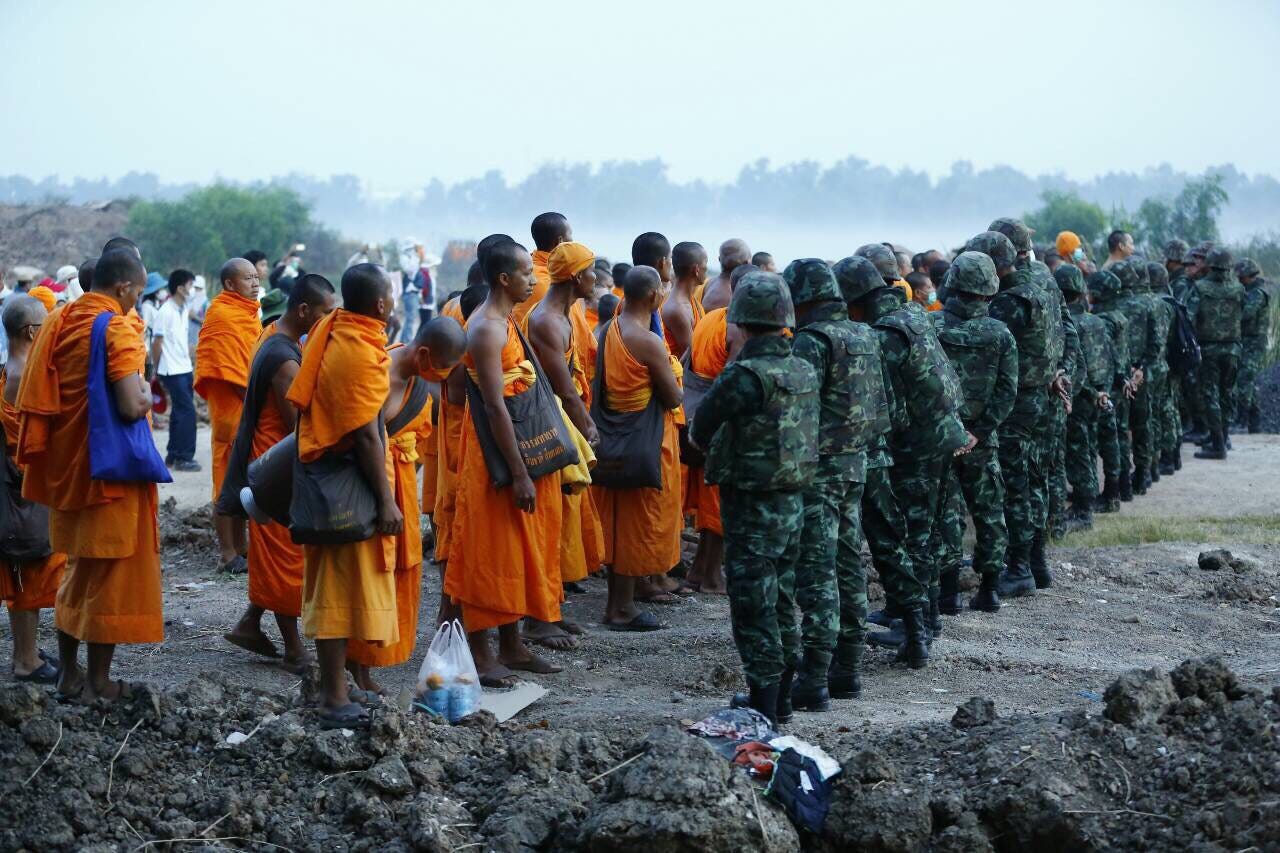
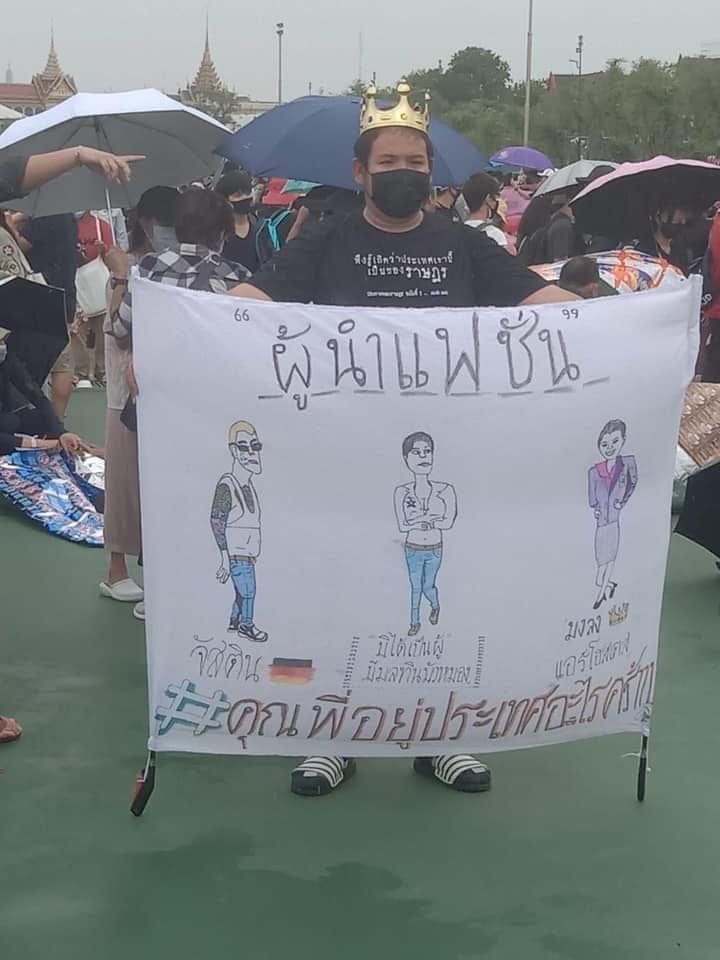
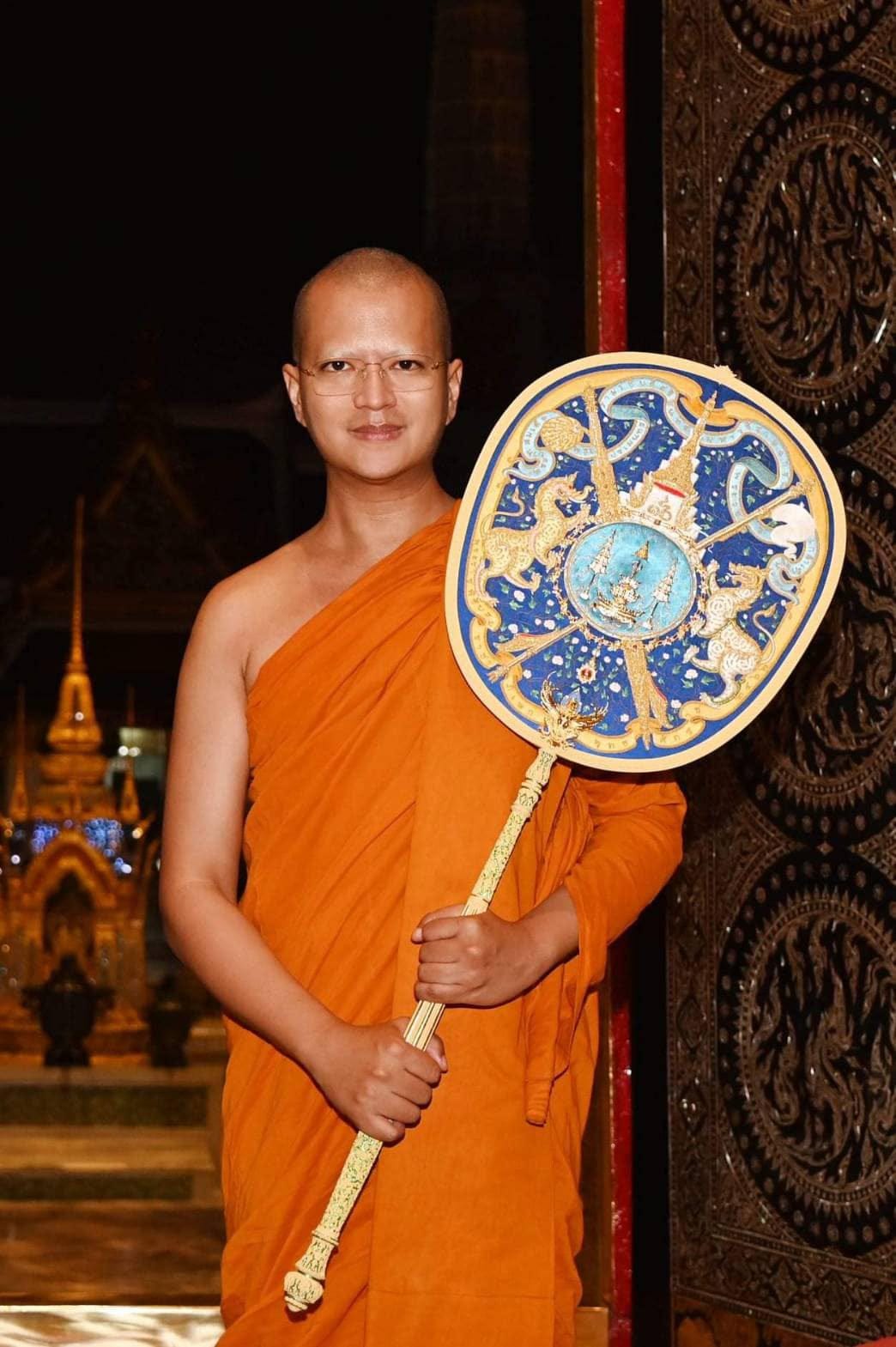
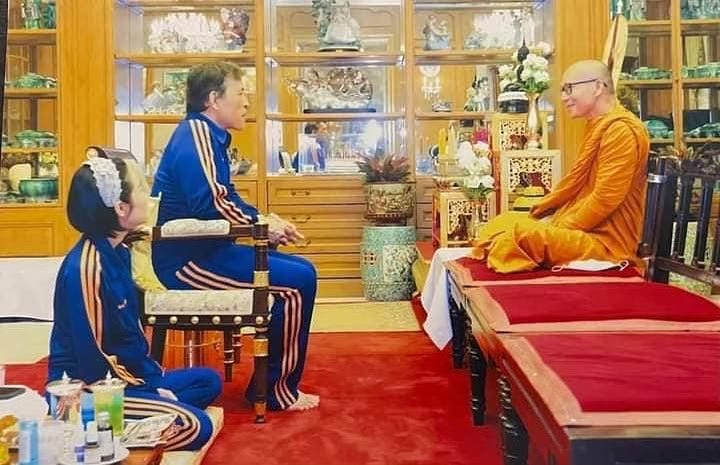
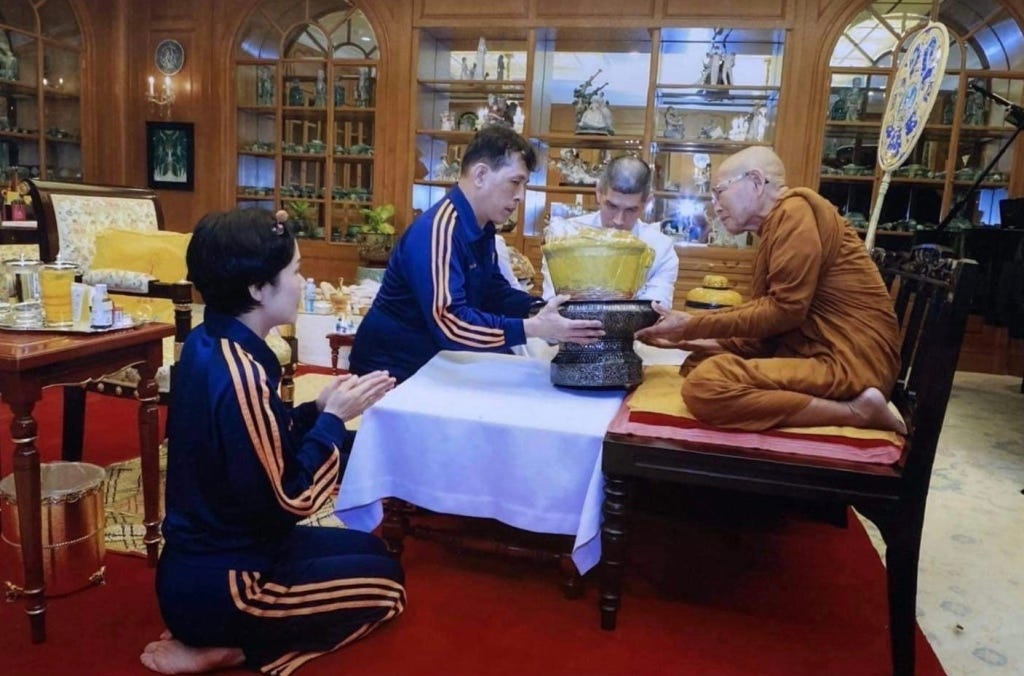





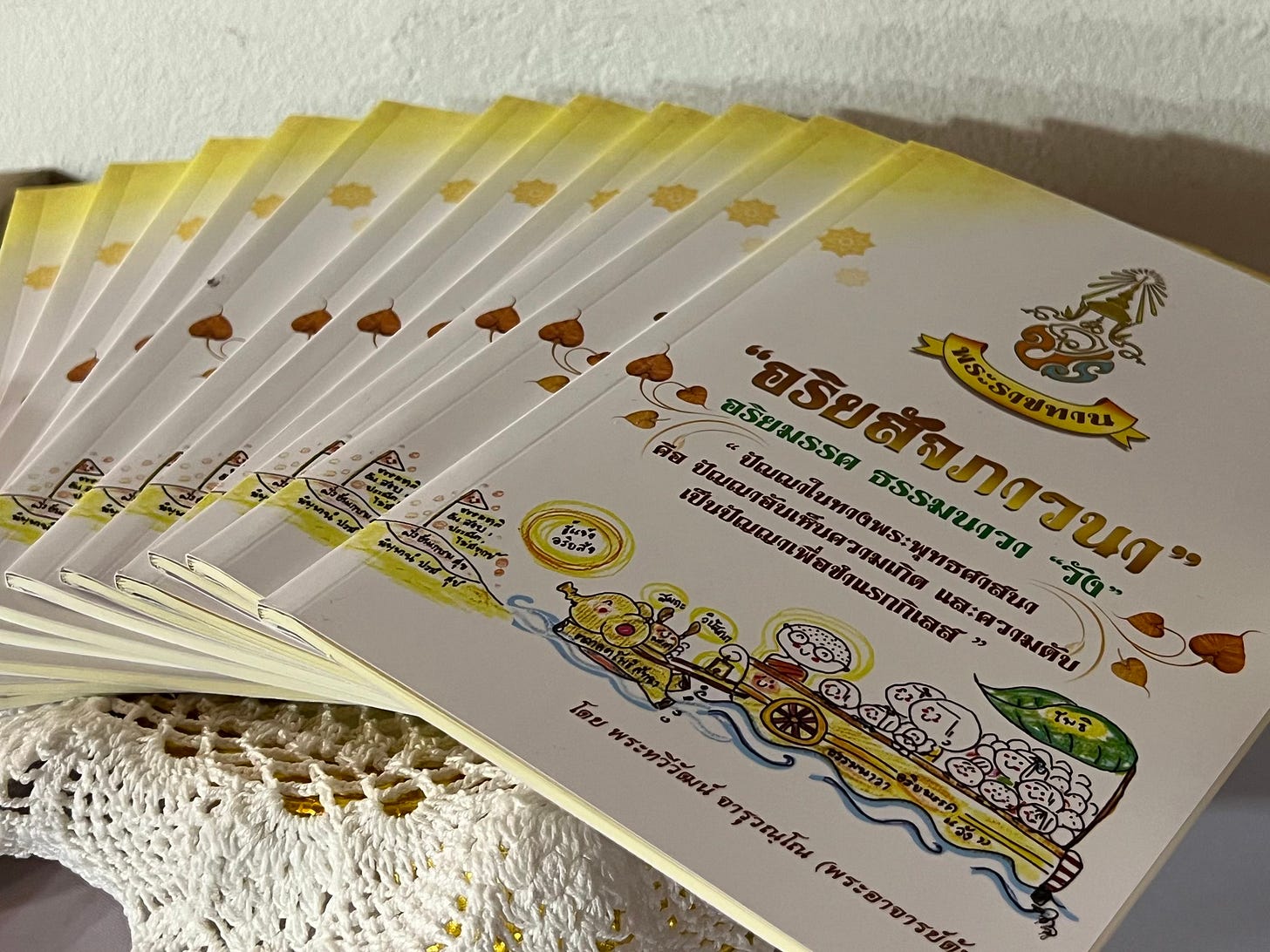



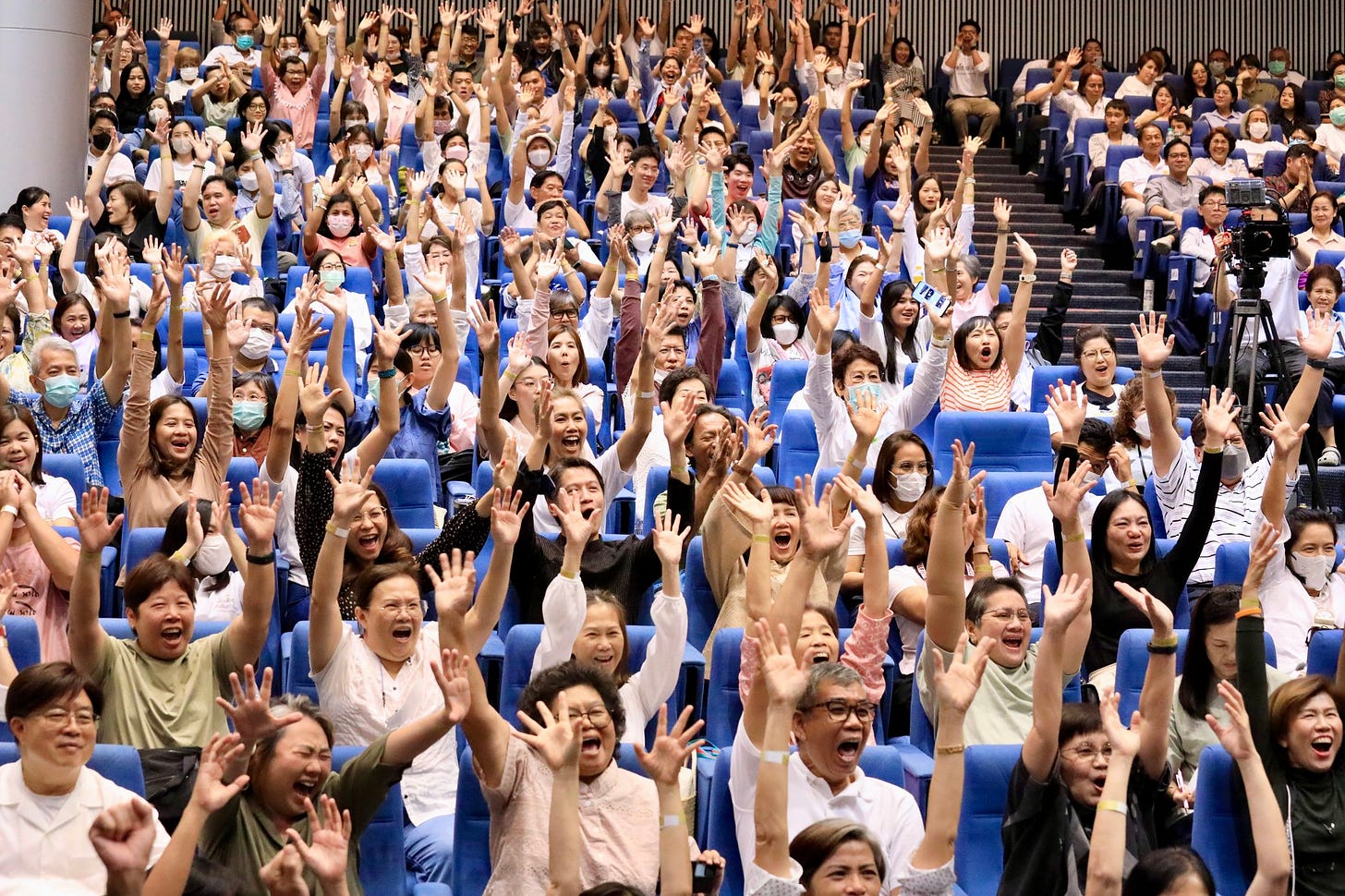
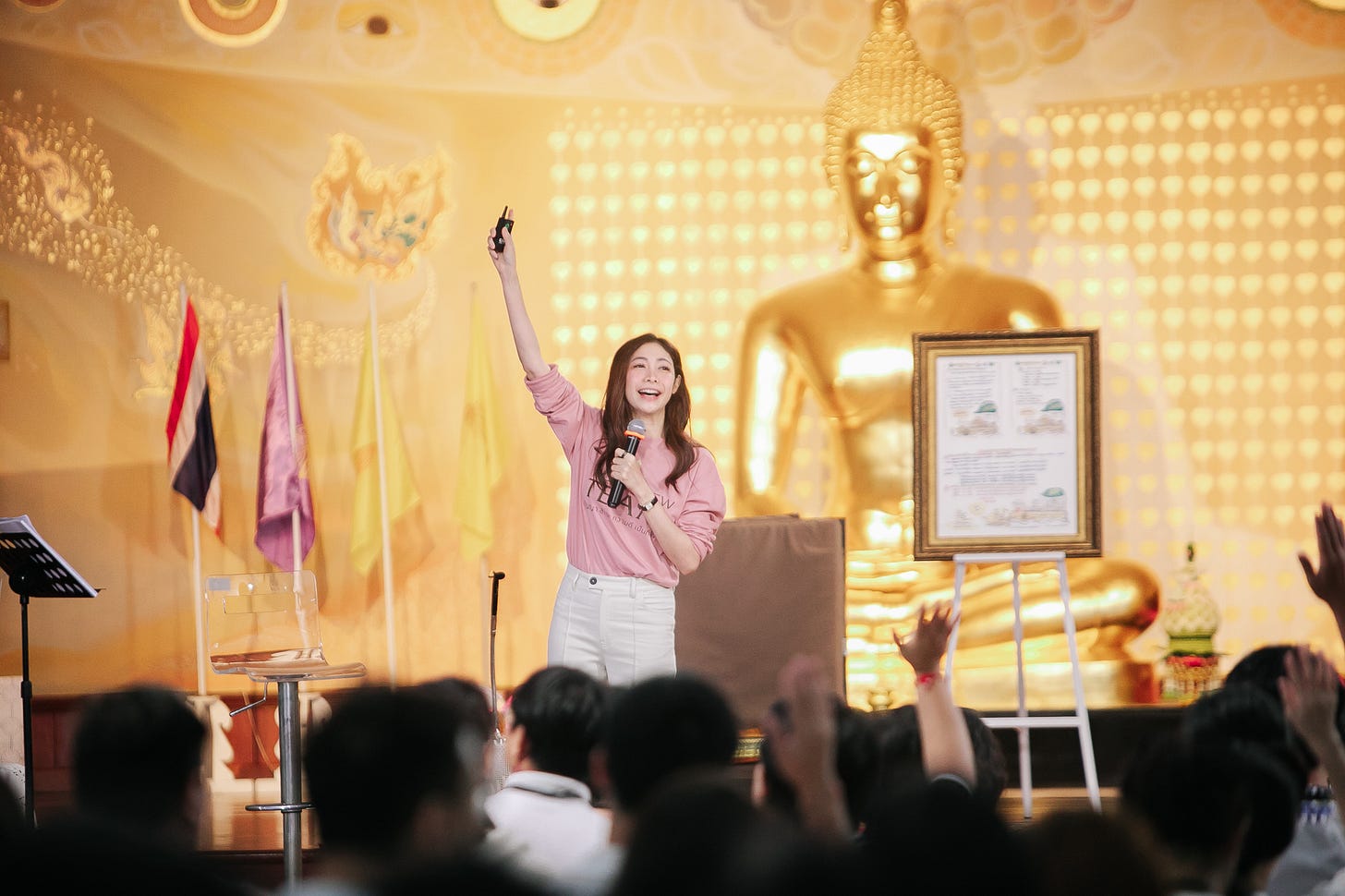


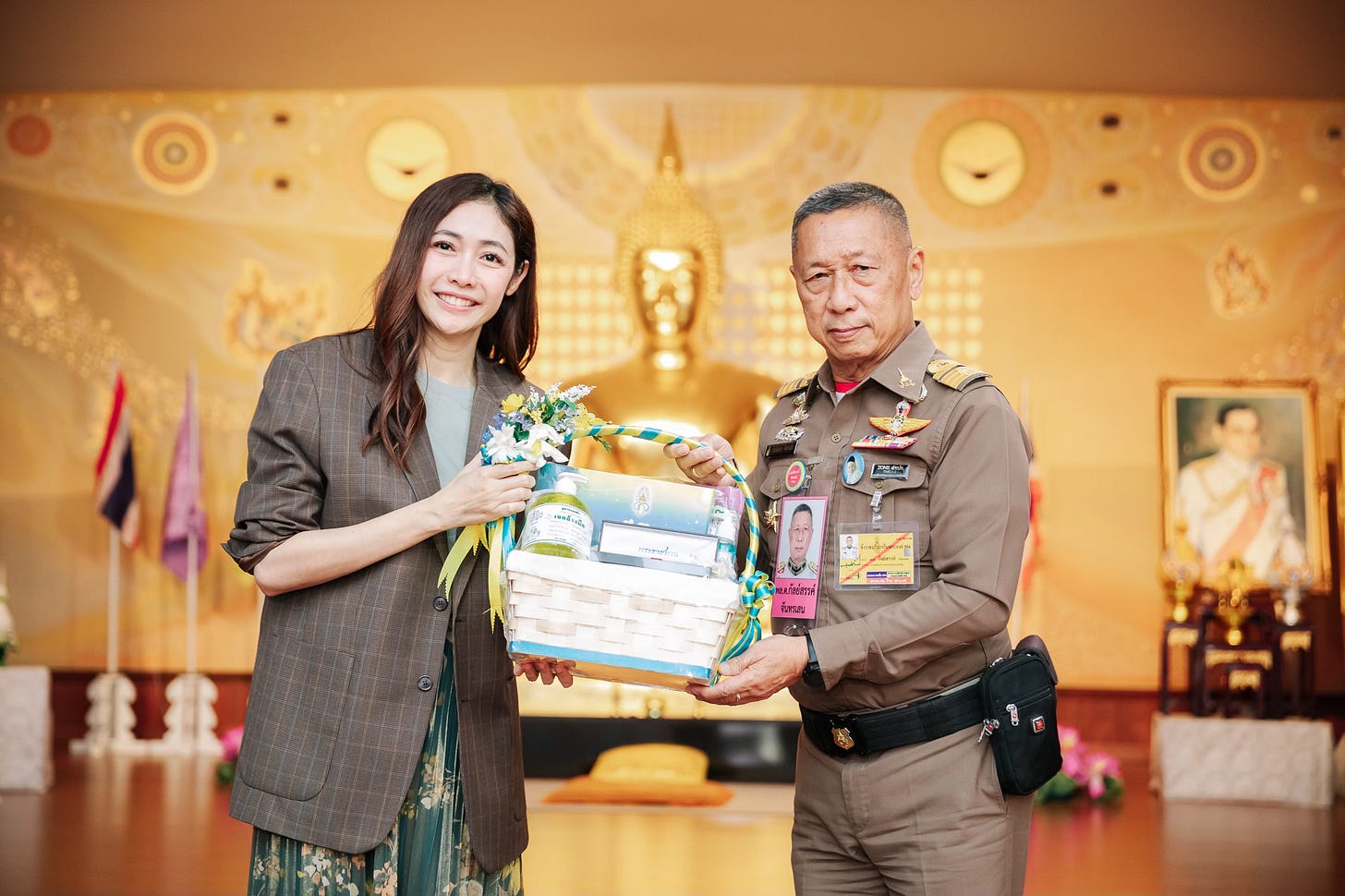
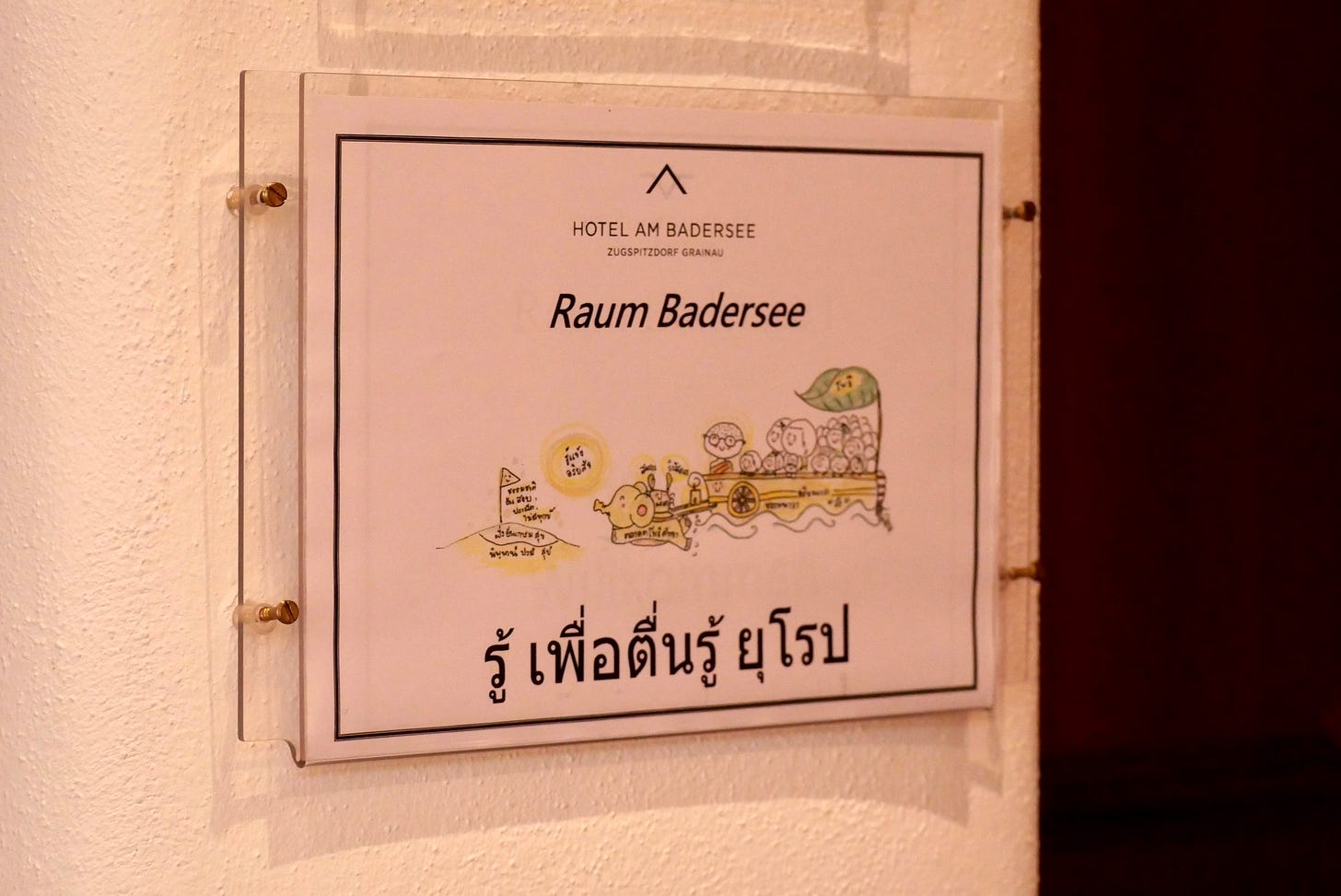
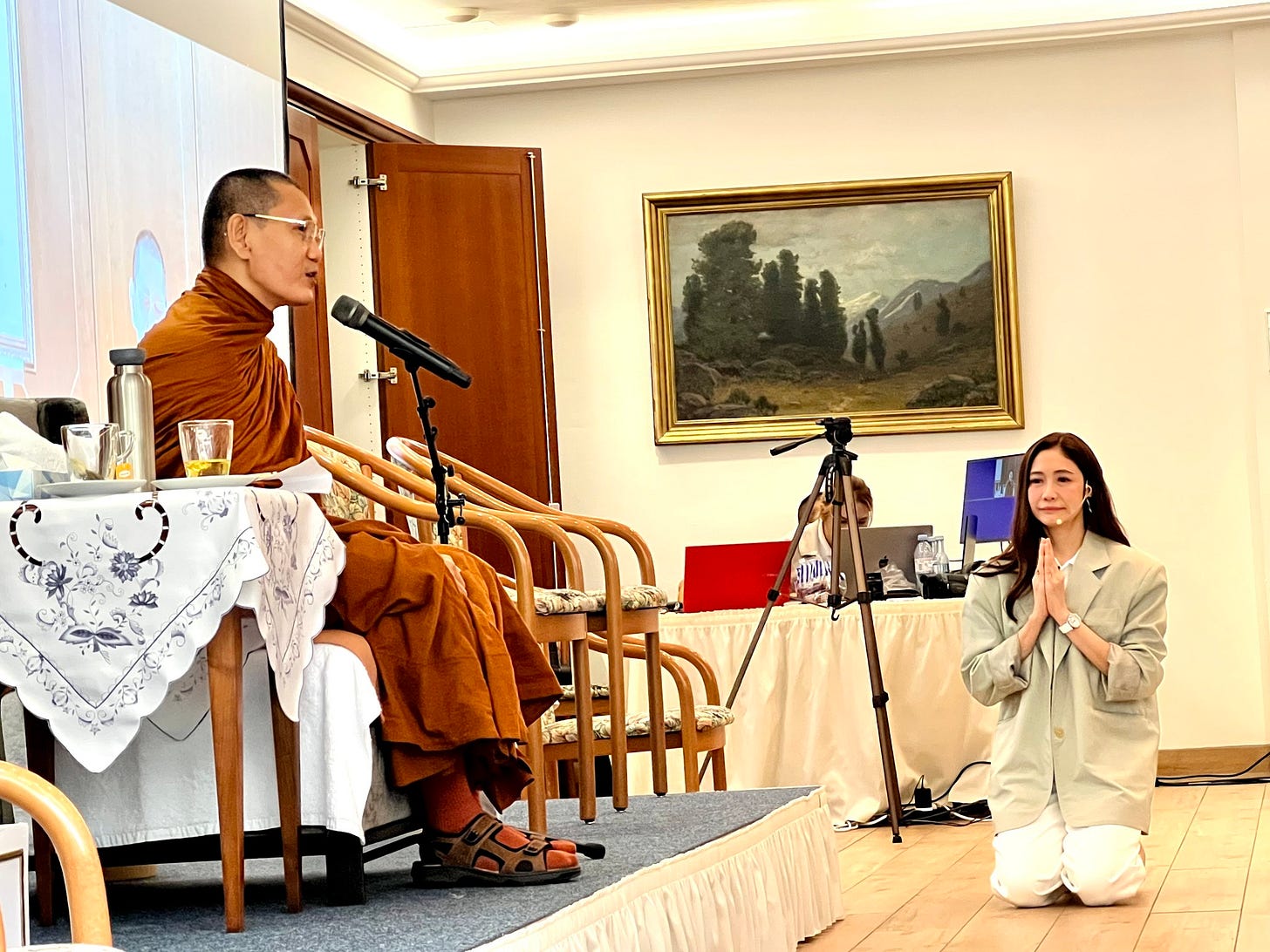
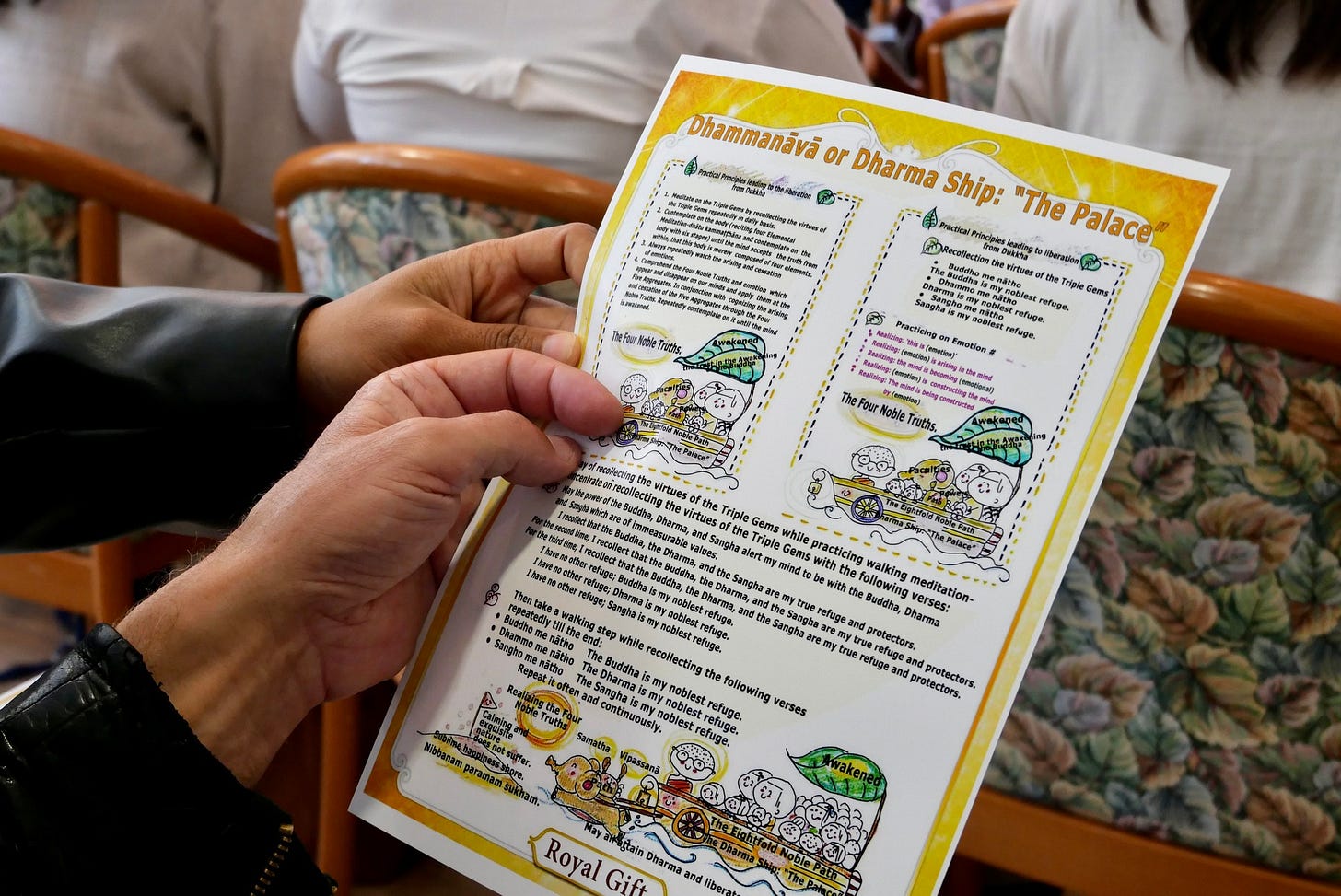
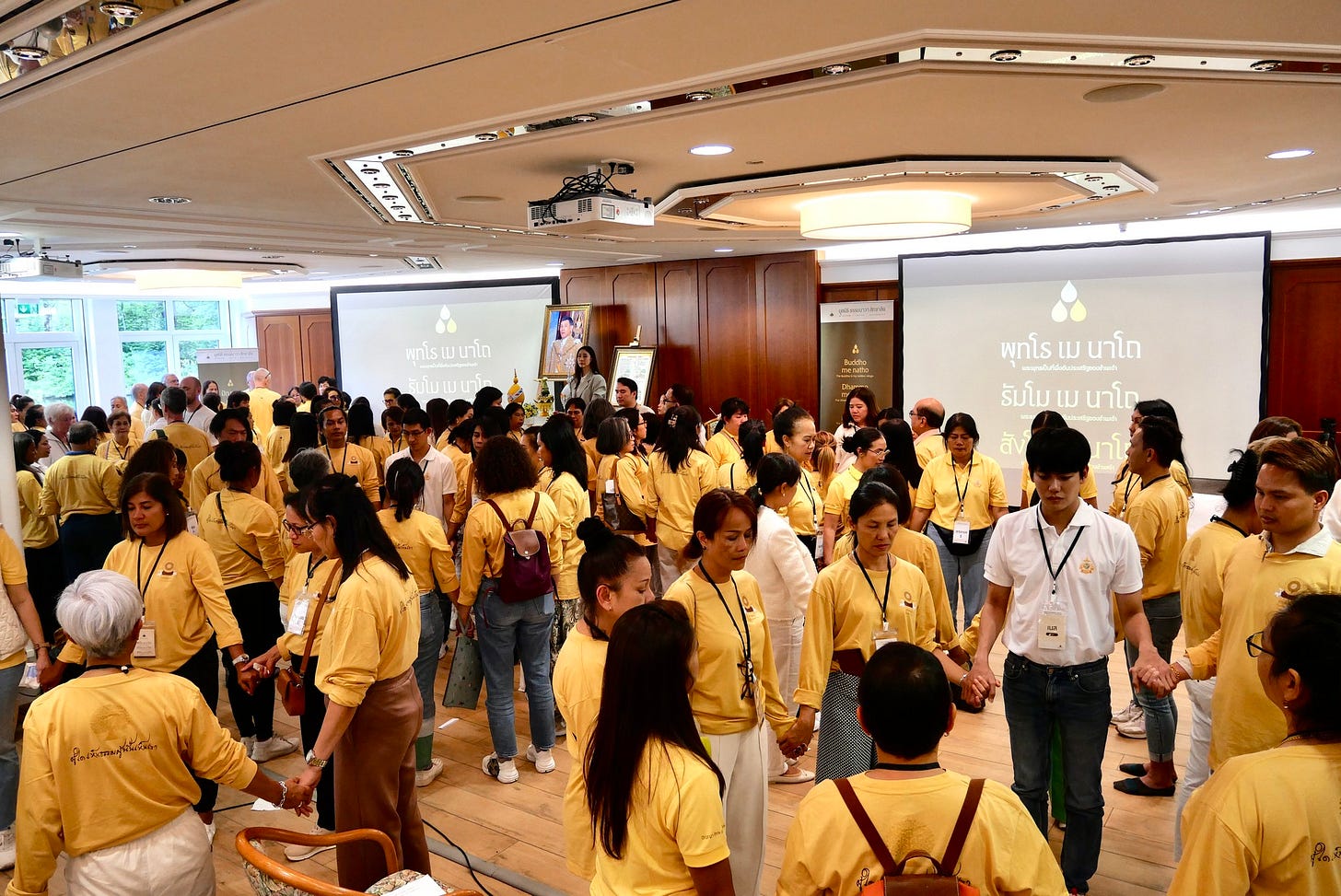


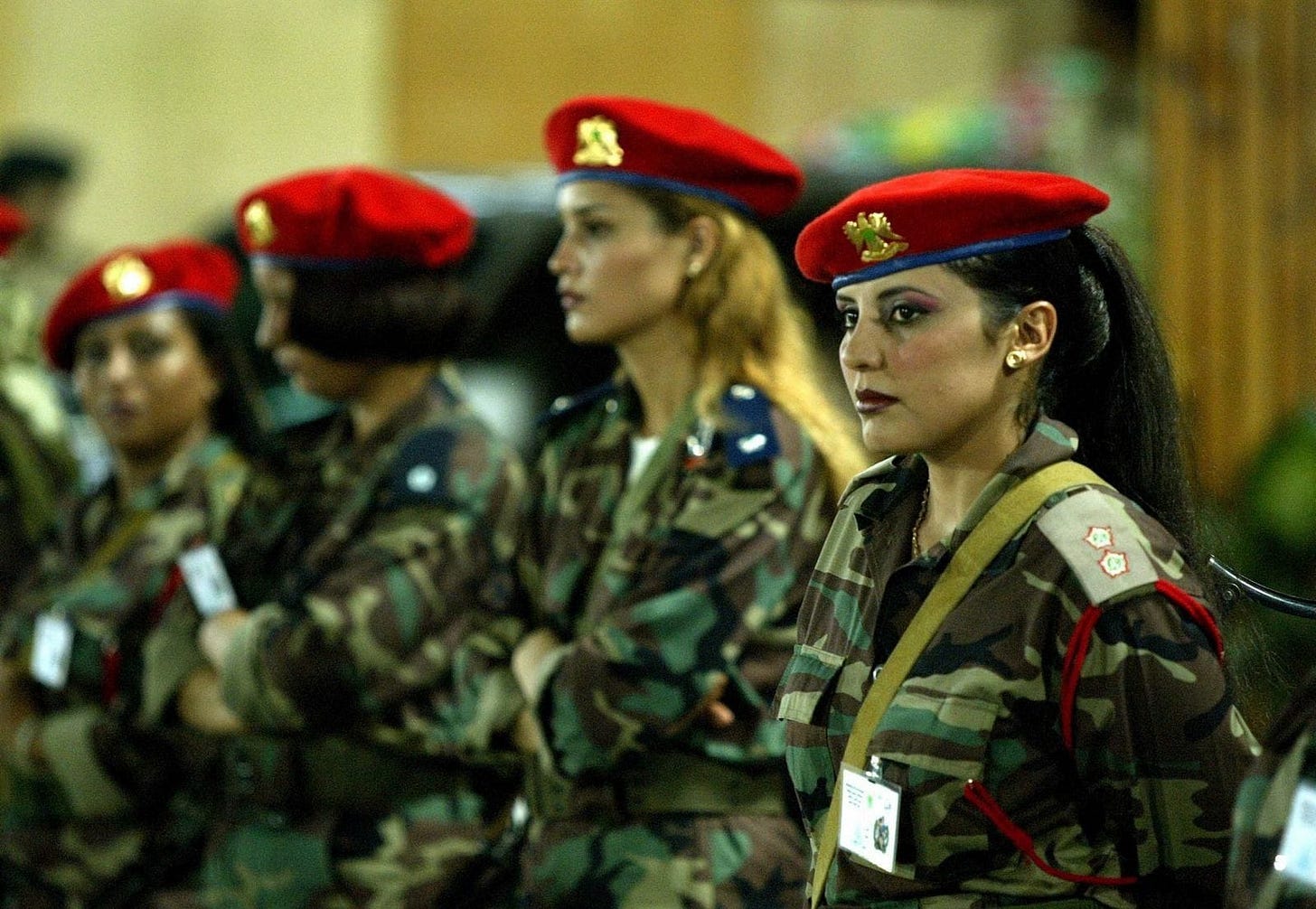

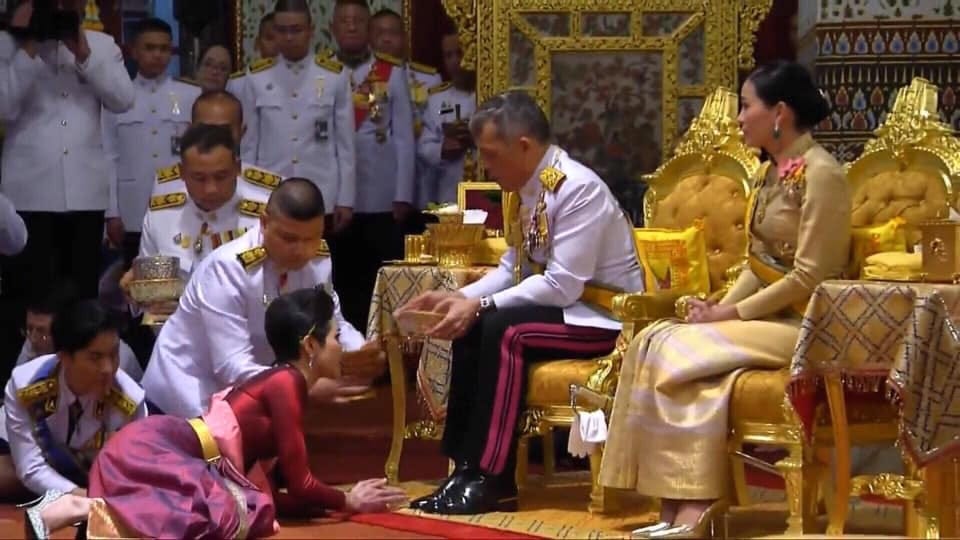




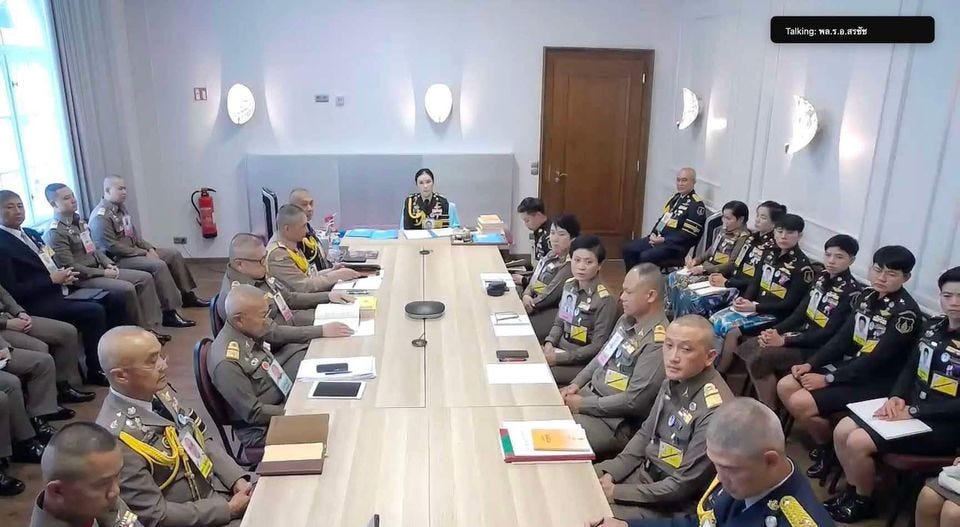
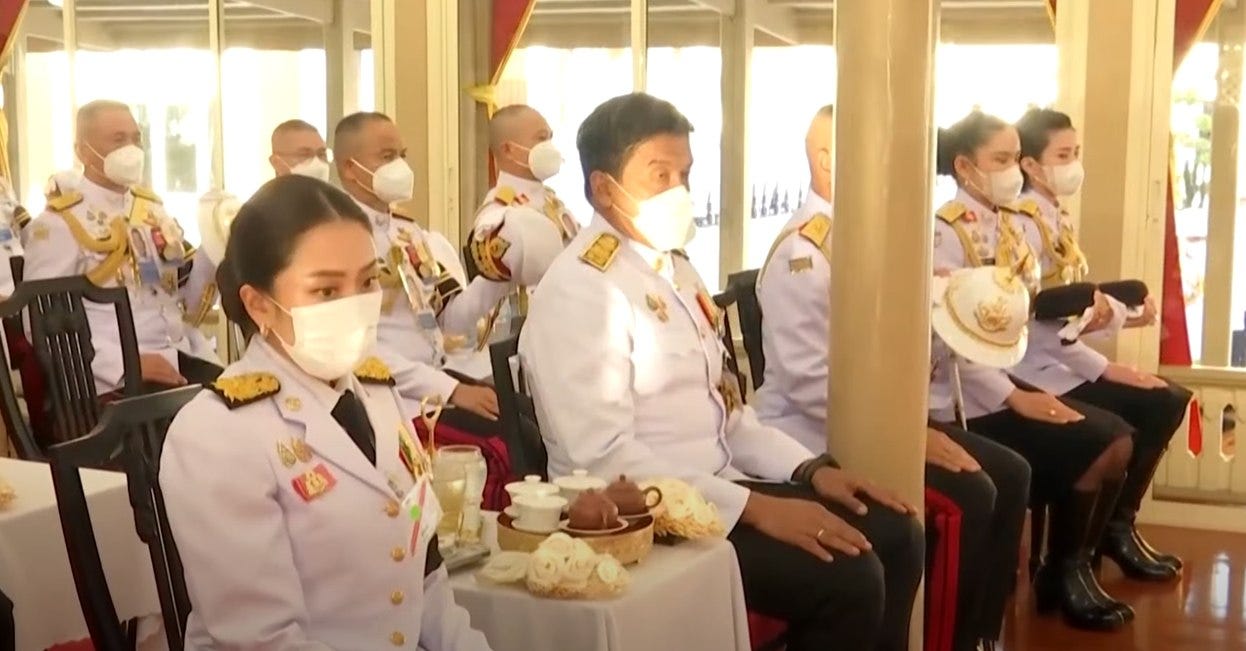
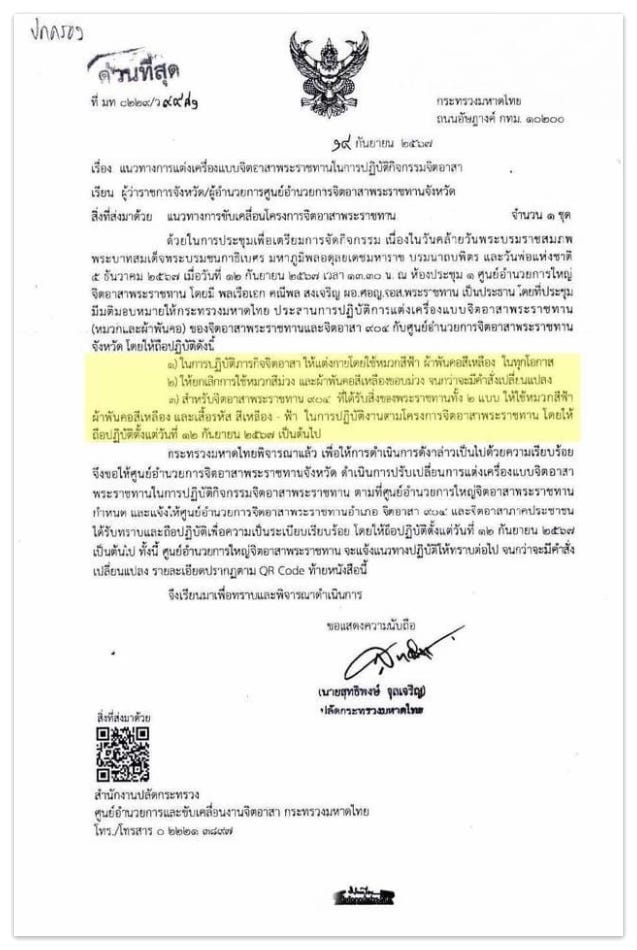
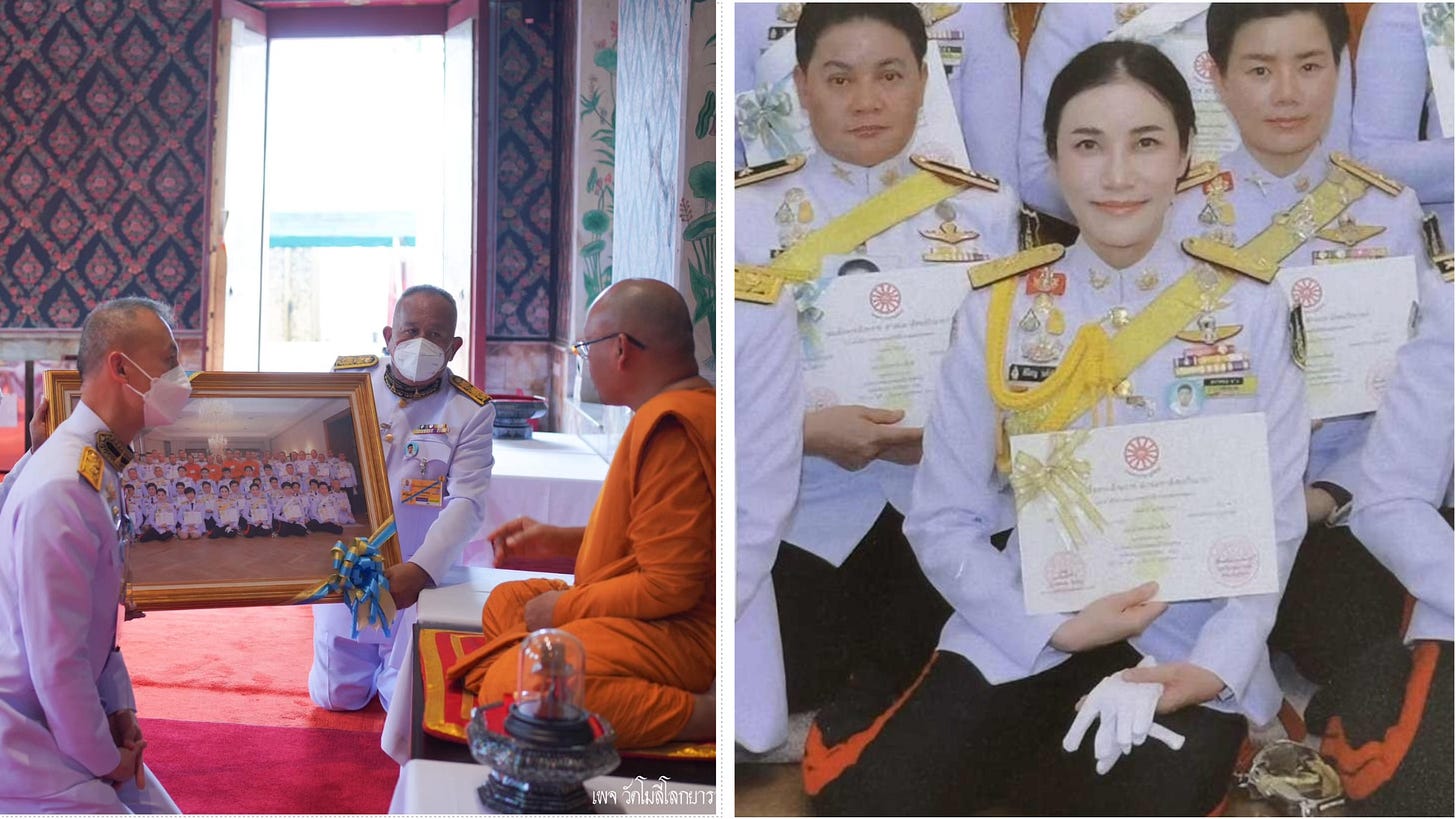


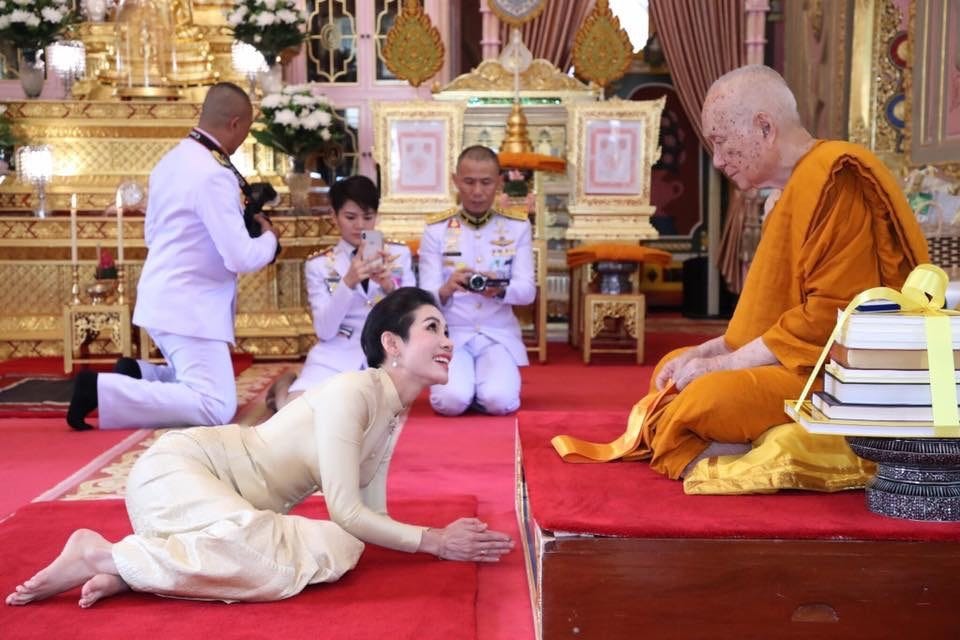


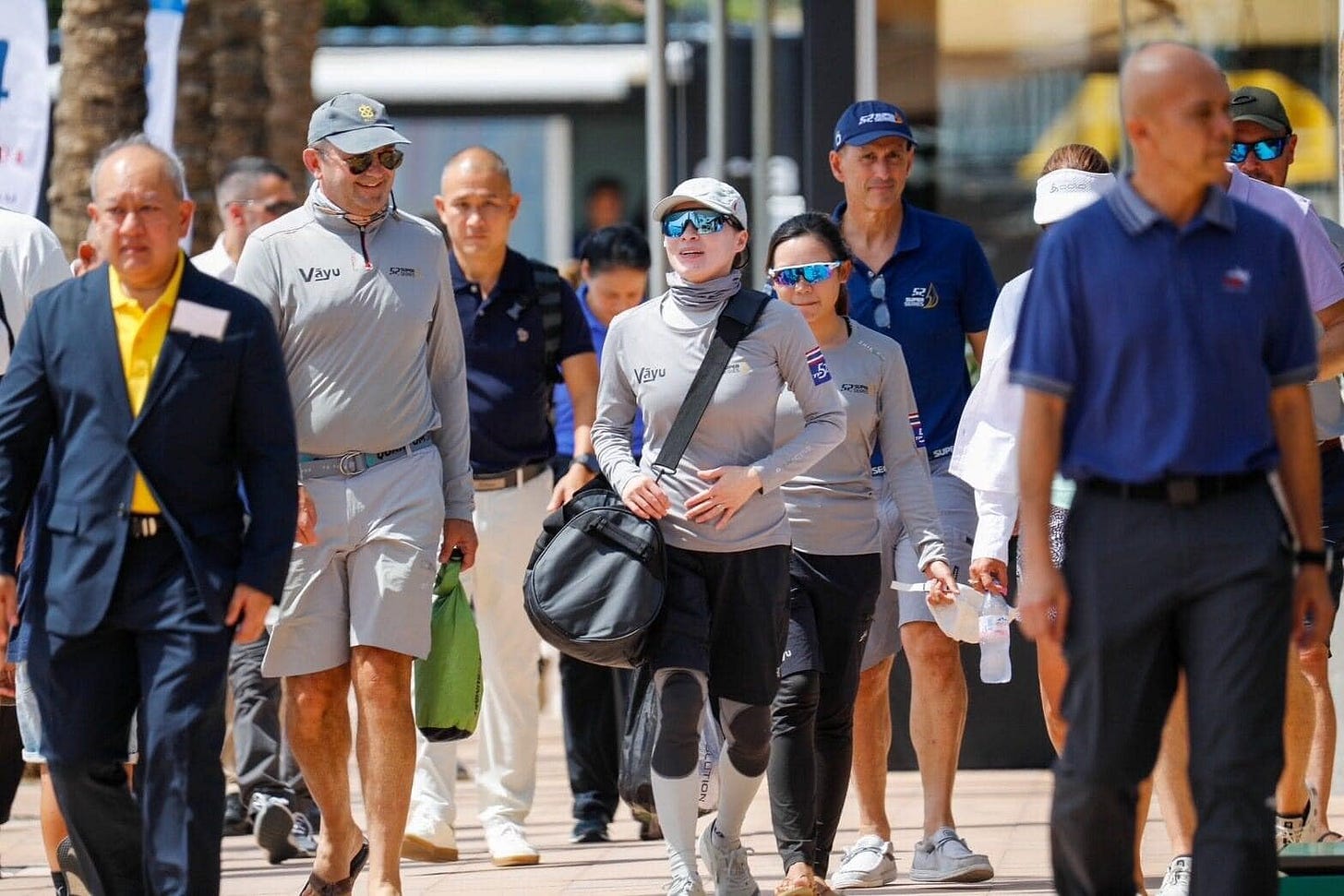

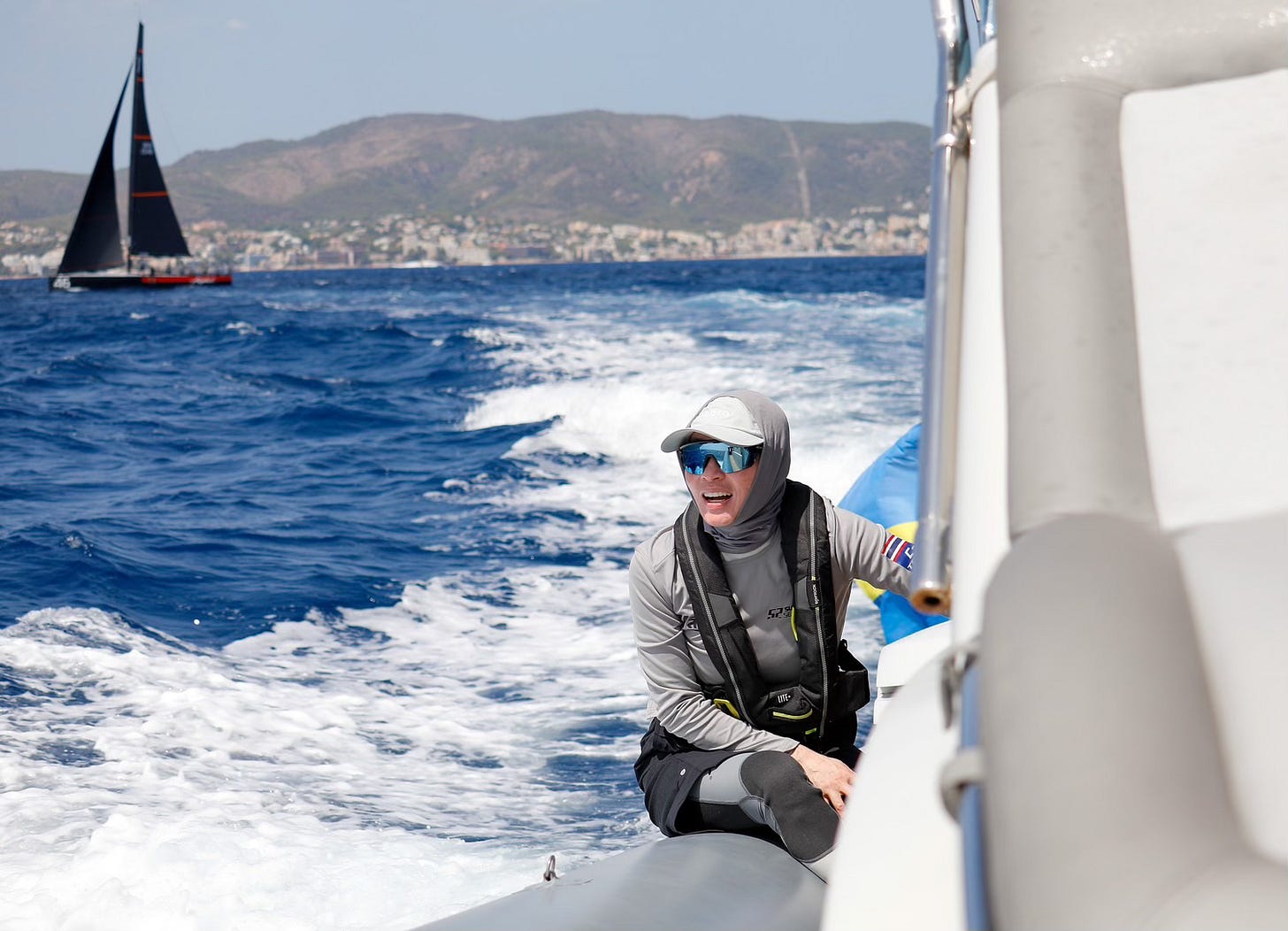
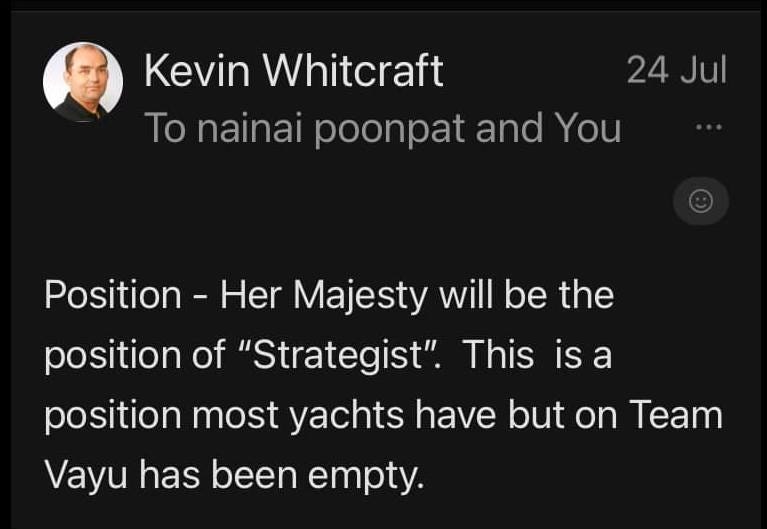

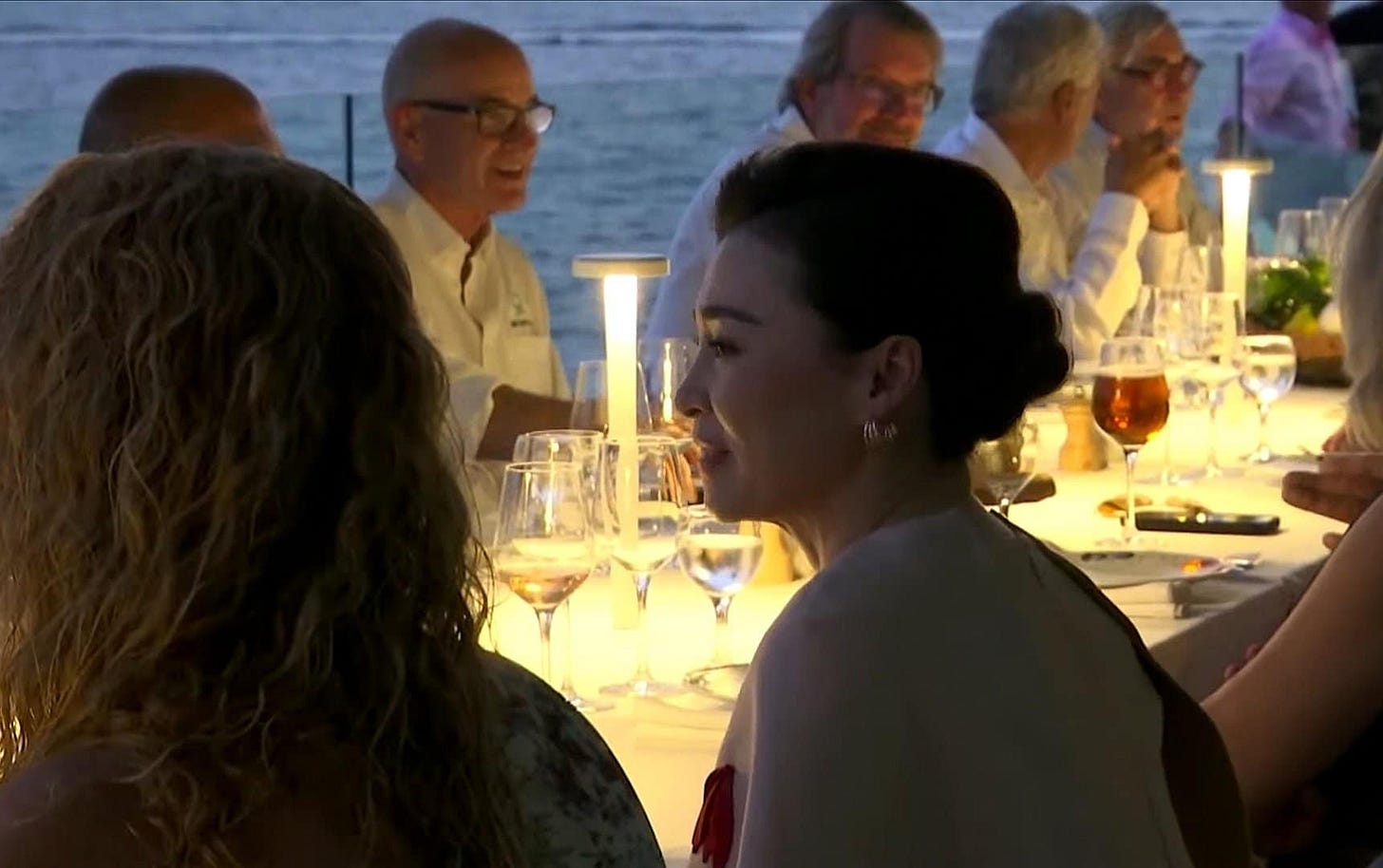
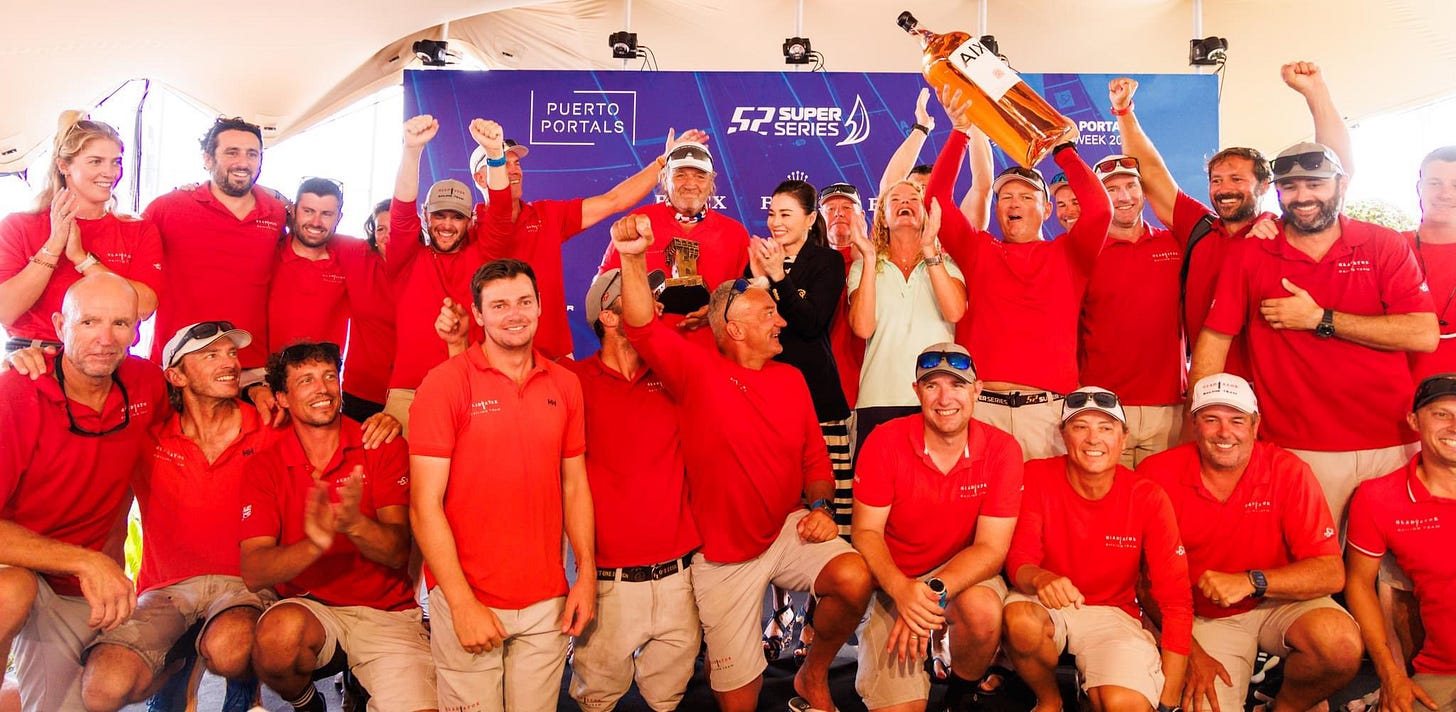

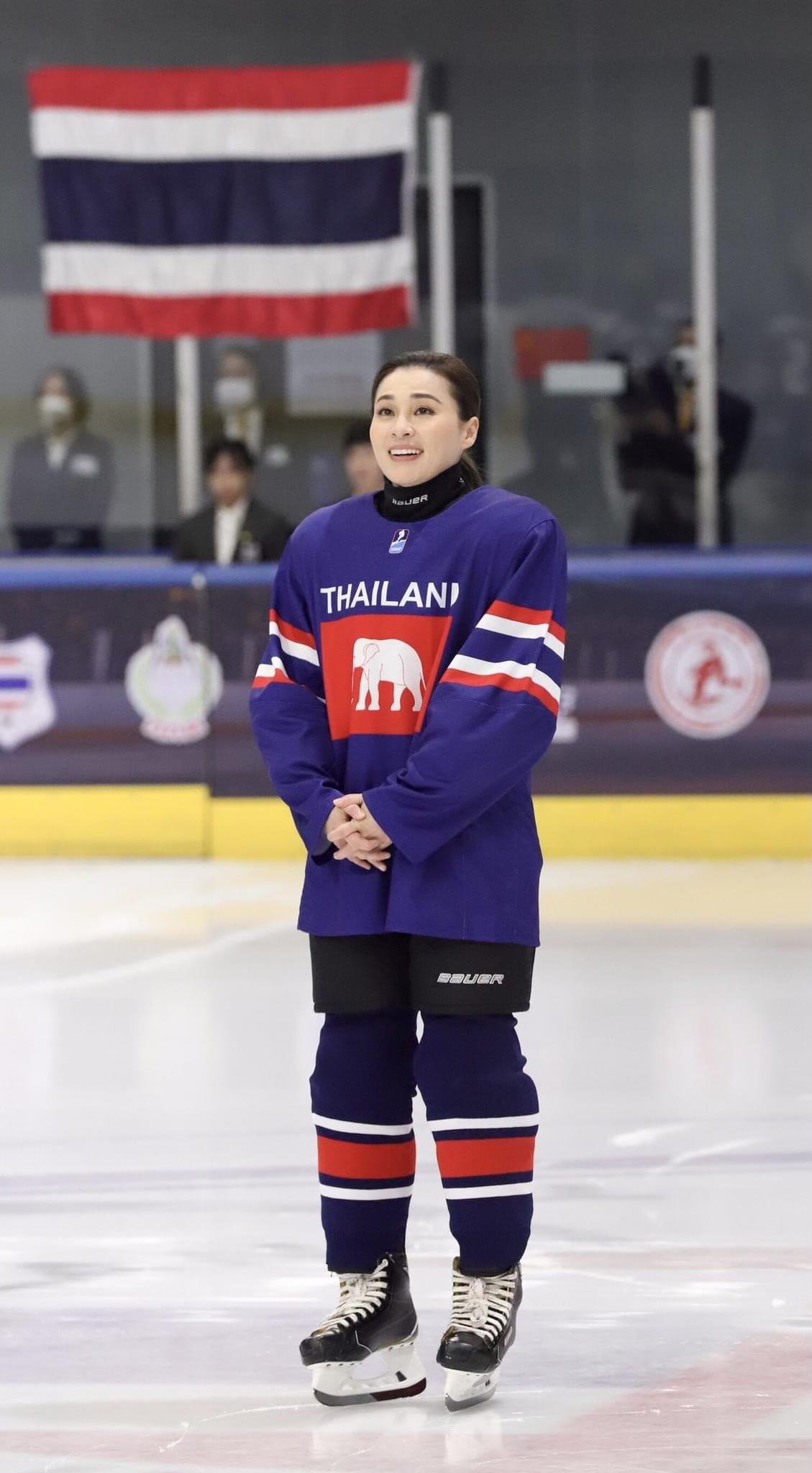
and the beat goes on... man, Andrew, your reports are always so comprehensively researched and detailed, you are doing a great public service in the face of obviously persistent danger, since the capricious X's goons are dispatched everywhere by the vengeful, sadistic monster